Inbox and Environment News: Issue 496
May 30 - June 5, 2021: Issue 496
Proposal To Allow Dogs Offleash On To Mona Vale Beach And Palm Beach
Avalon Golf Course Bush Regeneration Work Stopped
Avalon Golf Course bush regeneration is at a crossroads. The $10000 grant funded contract bush regeneration work is finished. The major weeds are still there, and in the surrounding gardens. Have a look at the attached information in case you have these weeds on your land. The bushcare group has stopped work for lack of support.
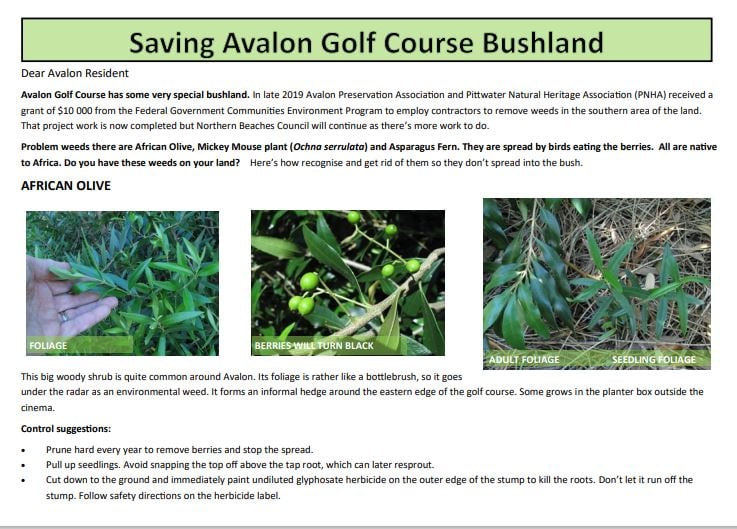
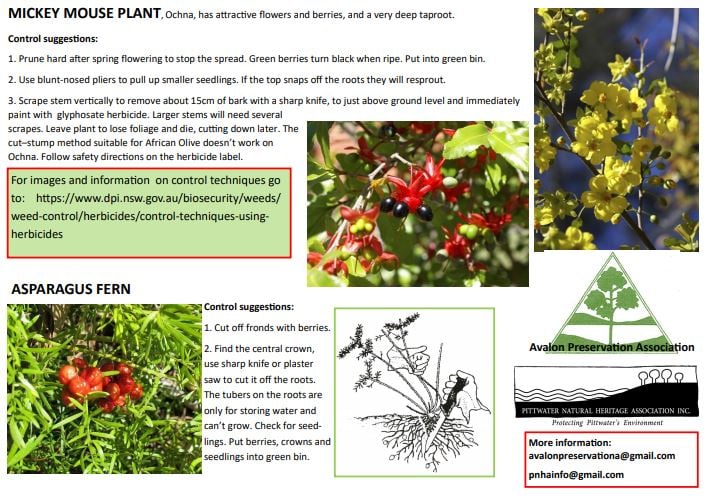
Students Win Landmark Climate Case. In Global First, Minister Has Duty Of Care To Protect Young People From Climate Change
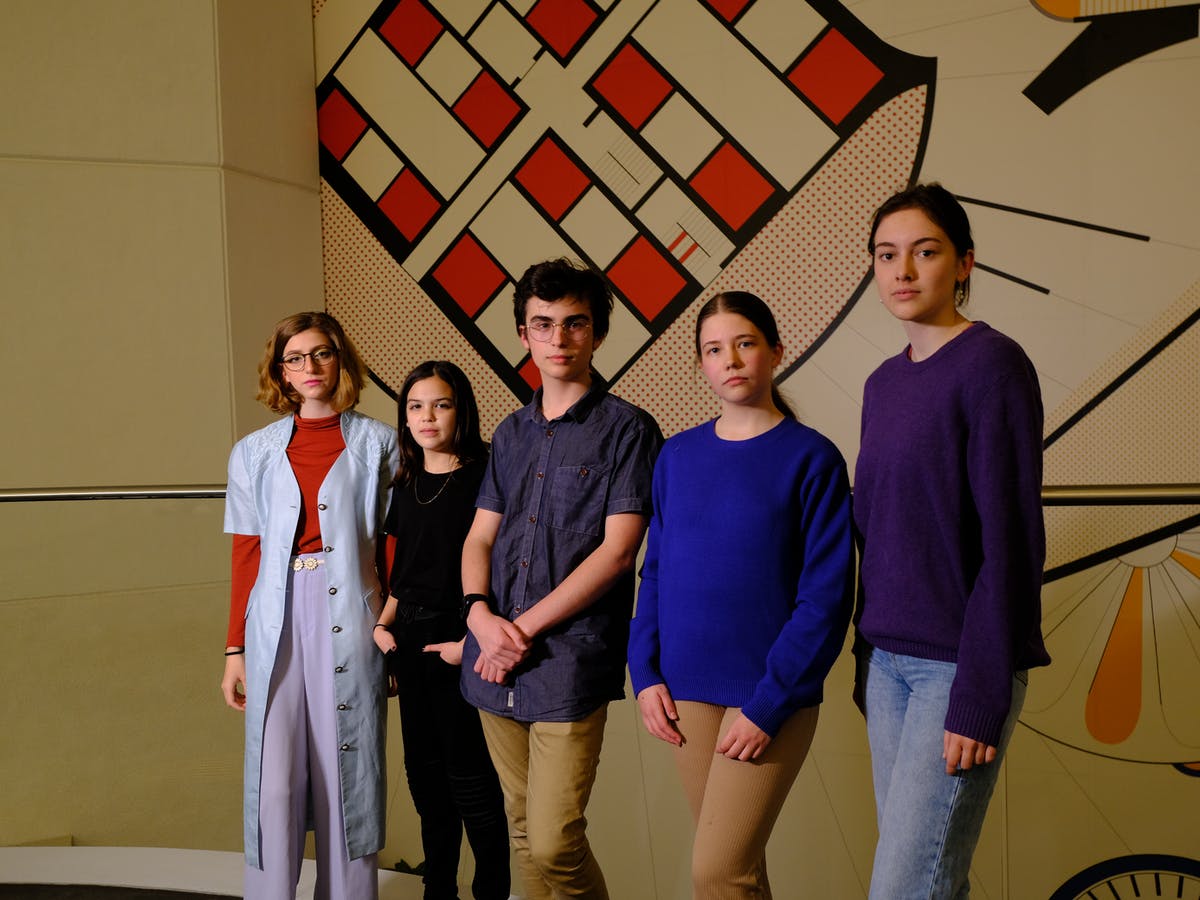
In a landmark judgment, the Federal Court found the environment minister has a duty of care to young people
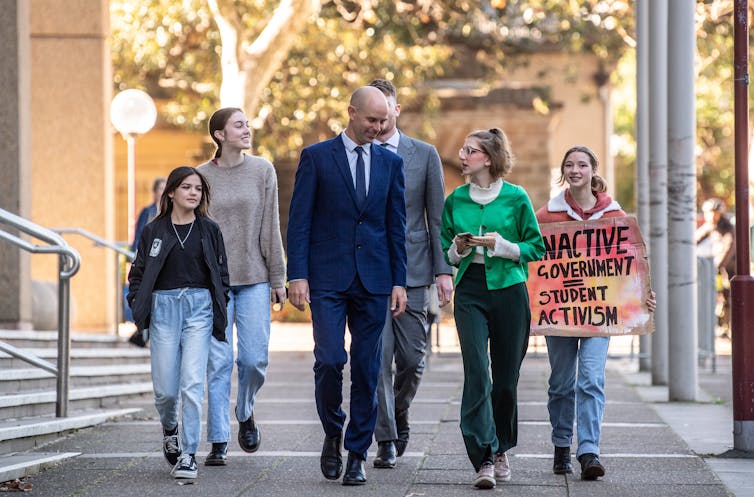
This morning, the Australian Federal Court delivered a landmark judgement on climate change, marking an important moment in our history.
The class action case was brought on behalf of all Australian children and teenagers, against Environment Minister Sussan Ley.
Their aim was to prevent Ley from possibly approving the Whitehaven coal mine extension project, near Gunnedah in New South Wales. They argued that approving this project would endanger their future because of climate hazards, including causing them injury, ill health, death or economic losses.
The court dismissed the application to stop the minister from approving the extension. But that’s just the beginning.
Before making those orders, the court found a new duty it never has before: the environment minister owes a duty of care to Australia’s young people not to cause them physical harm in the form of personal injury from climate change.
‘Australia Will Be Lost’: The Court’s Moving Findings
The court considered evidence in the case from the Intergovernmental Panel on Climate Change, CSIRO, the Bureau of Meteorology, and globally renowned ANU climate scientist Will Steffen.
In a tear-jerking moment during the Federal Court’s live-streamed summary, the court found that one million of today’s Australian children are expected to be hospitalised because of a heat-stress episode, that substantial economic loss will be experienced, and that the Great Barrier Reef and most of Australia’s eucalypt forest won’t exist when they grow up.
It found this harm is real, catastrophic, and – importantly from a legal perspective – “reasonably foreseeable”. In decades past, courts have considered climate change to be a “speculative”, “future problem”.
That is no longer the case. The court concluded, in a moving paragraph from the written judgment:
It is difficult to characterise in a single phrase the devastation that the plausible evidence presented in this proceeding forecasts for the children. As Australian adults know their country, Australia will be lost and the world as we know it gone as well.
The physical environment will be harsher, far more extreme and devastatingly brutal when angry. As for the human experience – quality of life, opportunities to partake in nature’s treasures, the capacity to grow and prosper – all will be greatly diminished.
Lives will be cut short. Trauma will be far more common and good health harder to hold and maintain.
None of this will be the fault of nature itself. It will largely be inflicted by the inaction of this generation of adults, in what might fairly be described as the greatest inter-generational injustice ever inflicted by one generation of humans upon the next.
To say that the children are vulnerable is to understate their predicament.
Establishing A New Duty Of Care
The children took a novel route in asserting the federal environment minister owed them a duty of care. A duty of care means a responsibility not to take actions that could harm others. A duty of care is the first step in a claim of negligence.
A similar duty was found in the Netherlands in 2015, as a global first. In 2019, the Supreme Court upheld that duty – the Dutch government owed it citizens a duty to reduce emissions in order to protect human rights.
Other cases around the world were inspired by that success, including the one decided in Australia today.
The court today didn’t say the minister has a duty to stop all coal projects of any size, as it was only considering the Whitehaven extension project. But this is still hugely significant.
Australia has been repeatedly criticised on the global stage for its stance on new coal and climate change more generally. Now, we may find the decisions made by its environment ministers could amount to negligent conduct.
The Buck Doesn’t Stop At Governments
Back in the Netherlands, something else significant happened this week — the world learned the buck doesn’t stop at governments.
In what’s been described as “arguably the most significant climate change judgement yet”, a court in The Hague ordered Royal Dutch Shell, a global oil and gas company, to reduce its carbon dioxide emissions by 45% by 2030 compared with 2019 levels, via its corporate policy.
This could have far-reaching consequences for oil and gas companies all over the world, including in Australia.
So now we have a dual momentum — governments need to be careful what they approve, and fossil fuels companies need be careful what they propose.
Putting The Minister On Notice
It’s important to recognise Ley hasn’t made a decision yet to approve the coal mine extension. The young Australians were seeking to stop her from approving it, and in that they didn’t succeed.
However, her responsibility to young people has now been formally recognised by the court.
Today’s children are vulnerable to climate change and they depend on the environment minister to protect their interests. We don’t know yet if the minister will approve the mine extension, or if she does, whether that means she has breached her duty to the children. But we do know how significant the harm from climate change will be.
What’s more, in 2019, a NSW court confirmed now is not the time to be approving new coal, and every coal mine counts.
Today’s judgement opens the door for future litigation if the minister is not careful about approving projects that could harm the next generations of Australians.
But importantly, it puts the federal environment minister on notice — while political terms might be only short, decisions now have intergenerational consequences for the future.
Short-term financial gain can have detrimental consequences for the health and economic wellbeing of those who can’t vote yet.
This story is part of a series The Conversation is running on the nexus between disaster, disadvantage and resilience. You can read the rest of the stories here.![]()
Laura Schuijers, Research Fellow in Environmental Law, The University of Melbourne
This article is republished from The Conversation under a Creative Commons license. Read the original article.
Climate change will cost a young Australian up to $245,000 over their lifetime, court case reveals
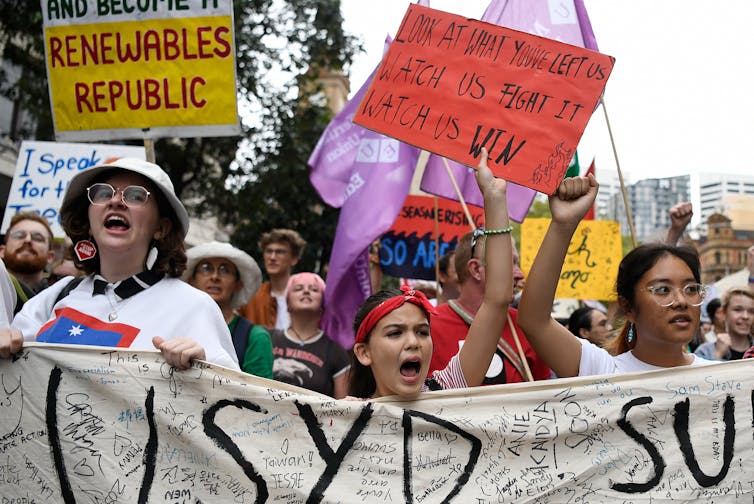
The Federal Court today dismissed a bid by a group of Australian teenagers seeking to prevent federal environment minister Sussan Ley from approving a coalmine extension in New South Wales.
While the teens’ request for an injunction was unsuccessful, a number of important developments emerged during the court proceedings. This included new figures on the financial costs of climate change to young Australians over their lifetimes.
An independent expert witness put the loss at between A$125,000 and A$245,000 per person. The calculation was a conservative one, and did not include health impacts which were assessed separately.
The evidence was accepted by both the federal government’s legal team and the judge. That it was uncontested represents an important shift. No longer are the financial impacts of climate change a vague future loss – they’re now a tangible, quantifiable harm.
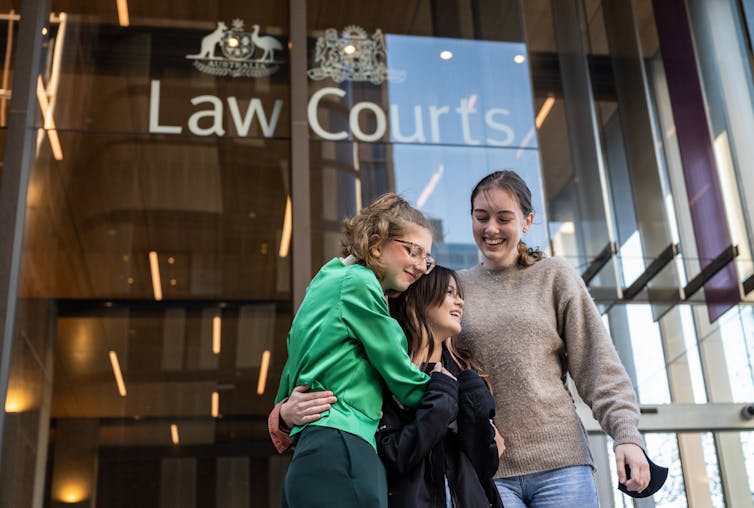
Calculating Climate Costs
The case involved a proposed extension to Whitehaven’s Vickery mine near Gunnedah in northwest NSW. The expansion would increase the total emissions over the life of the mine to 366 million tonnes.
To help in its deliberations, the court called on an independent expert witness, Dr Karl Mallon, to estimate the extent to which climate change would harm the eight young Australians aged 13 to 17, and by extension all children in Australia.
Mallon is chief executive of Climate Risk, a consultancy specialising in climate risk and adaptation software which advises governments and businesses around the world. This is the first time anywhere in the world this technique for quantifying harm in climate litigation has been applied and accepted.
Mallon first assumed a level of ongoing greenhouse gas emissions, with reference to standard scenarios used by the Intergovernmental Panel on Climate Change (IPCC). The scenarios range from futures with ambitious emissions reductions to those with very little.
So Mallon used the IPCC’s high-end emissions scenario known as RCP8.5 - the only one consistent with increasing coal production.
Second, Mallon drew on atmospheric modelling to provide projections for Australia on climate effects such as changes in temperature and rainfall. He then quantified the financial and health costs of those changes across three “epochs”, or time periods, in the futures of young people today.
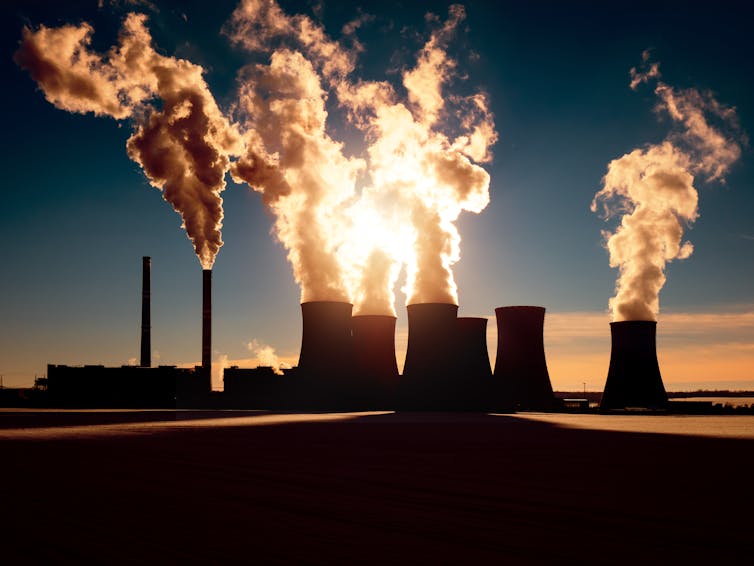
Epoch 1: Loss Of Property Wealth
The first epoch spanned the decade to 2030. Mallon limited his analysis to how climate change will affect housing markets, leading to the loss of family property wealth.
Some homes are particularly vulnerable to extreme weather and climate risks such as bushfires, flooding, coastal inundation, cyclones and subsidence. Mallon’s modelling found about 5% of family homes would be affected damaged by climate change and associated extreme weather events this decade.
Already in some areas insurance premiums are becoming unaffordable and the problem will likely worsen as climate change unfolds. This will reduce the market value of high-risk properties.
Mallon estimated an average loss to the value of family homes by 2030 at about A$40-85,000 per child.
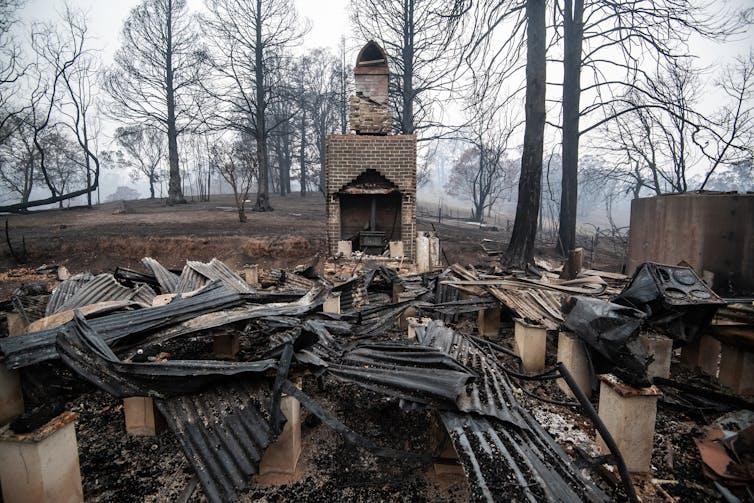
Epoch 2: Reduced Earnings
This epoch spanned the years 2040 to 2060, when the applicants would be aged between 20 and 58 years. This part of Mallon’s analysis focused first on loss to prosperity – how climate change would affect a young person’s ability to work.
On hot days, the body must expend extra energy dissipating heat (usually by sweating). As the International Labour Organisation has noted, exposure to these conditions for extended periods is risky, and to endure them people must drink water and take regular breaks, leading to lower productivity.
Rising temperatures under climate change will increase the number of days where the ability to work outside safely will be hampered. Mallon found around 30% of today’s children will work in climate-vulnerable jobs, such as agriculture and construction.
People in these jobs will be less productive, and the cost to employers will eventually be passed to employees through lower wages. Mallon estimated this means a loss of about A$75,000 over a young person’s working life.
Climate change and associated extreme weather will also disrupt the infrastructure businesses rely on, such as electricity, telecommunications and transport. Again, these productivity losses will eventually be reflected in employee wages.
In Mallon’s opinion, repeated extreme weather damage to business continuity will lead to an estimated average A$25,000 annual loss per person over the working life of a child today.
Climate change will also deliver general “hits” to the economy. Mallon’s analysis here focused only on agricultural and labour productivity, and drew on existing research to estimate losses of about A$60,000 per person over their lifetimes.
The bottom line? Mallon’s partial, conservative calculations found today’s children will forego between A$125,000 and A$245,000 each due to the climate impacts noted above. He puts the most likely cost at around A$170,000 for each child.
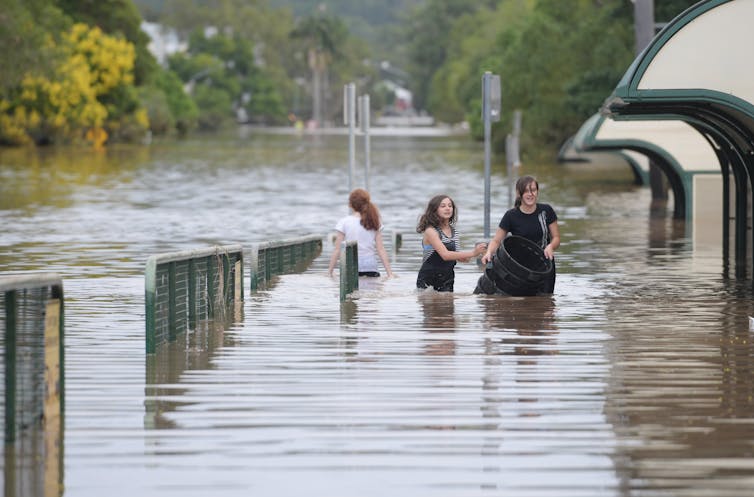
Epoch 3: Risks To Health
The third epoch spanned 2070 to 2100, when today’s young people will be in the later stages of their lives. Here, Mallon’s analysis focused on the health impacts of higher temperatures. These will lead to increased heat stress, ambulance call outs, presentations to emergency departments and hospitalisations.
Older people are more vulnerable to the health effects of higher temperatures, and also more likely to die. Mallon found one in five of today’s children will likely be hospitalised due to heat stress in their senior years.
Act Hard And Fast
In Australia and around the world, people concerned about climate change are increasingly using litigation in a bid to force governments to act.
This means we can expect to quantification of the financial costs of climate change being presented more often in our courts.
Mallon’s calculations do not cover the only harm that will be caused by climate change – only those for which detailed accessible modelling exists. The full financial and health costs will inevitably be far greater than the scope of his assessment.
Global emissions must urgently be cut to net-zero to avert the most disastrous climate change impacts. The arguments in favour of radical mitigation action, including the personal financial risks, grow ever-more compelling by the day.
This story is part of a series The Conversation is running on the nexus between disaster, disadvantage and resilience. You can read the rest of the stories here.![]()
Liam Phelan, Senior Lecturer, School of Environmental and Life Sciences, University of Newcastle and Jacquie Svenson, Clinical Teacher/Solicitor, University of Newcastle
This article is republished from The Conversation under a Creative Commons license. Read the original article.
Will To Keep Fighting Whitehaven Is Strong After Landmark Vickery Ruling
May 27, 2021
Communities across NSW’s North West have commended eight high school students and their 86 year-old litigation guardian Sister Brigid Arthur, after a ruling was handed down today on their challenge in the Federal Court to Whitehaven Coal’s destructive Vickery Coal Extension Project.
The group argued Federal Environment Minister Sussan Ley would breach her duty to protect young people from the devastating impacts of climate change if she approved the project.
In a landmark judgement, the Federal Court today ruled the Minister does owe a ‘duty of care’ to protect Australian children from the effects of catastrophic climate change. The Court drew a direct line between the mining of coal at Vickery and worsening climate change.
The Court did not grant an injunction preventing the Minister from approving the Vickery coal mine extension, but did provide another opportunity for legal arguments about the matter next month.
Boggabri farmer Sally Hunter said the ruling was a very important landmark because the Court had confirmed the Minister had a duty of care to consider the future wellbeing of the students when ruling on fossil fuel projects and that this particular project would worsen climate change.
“Locals in the North West would like to express their gratitude to this group of students and Sister Arthur for trying to stop the project and standing up for the future we all need to farm, to live and to prosper," she said.
“I appreciate these efforts to protect my childrens’ future too. Burning coal from Vickery will worsen all our childrens’ future so we are pleased to stand side by side in this battle against this destructive project.
“Whitehaven’s Vickery Project, if built, would have a devastating impact on heritage, prime farmland, and the groundwater so many depend on, as well as the climate.
“Today’s ruling establishes that the Minister for the Environment has a duty of care to protect these students from the catastrophic consequences of climate change, and that coal mined from Vickery will make a “small but measurable” contribution to global warming.
“If Minister Ley approves this project, she will be harming the futures of Australian children and further contributing to making the worst impacts of global warming inevitable and irreversible. She must refuse the project.
“As well, if Minister Ley approves this project despite today's judgment, she would be locking our region into a future dominated by a finite industry that is already on the way out.
“Workers and families ought to be able to expect the government to deliver jobs that will last beyond a few years. Now is the time to shift to renewables.”
More information:
- If built, the coal burned from the Vickery Extension Project would result in 100 million tonnes of carbon emissions over the next 25 years.
- While Whitehaven refers to the Vickery Project as an “extension”, this is misleading because the original mine was never built - it is an expansion on top of an approved application to build a mine in the same location.
- The mine, if built, would be located on the historic property “Kurrumbede” which was the inspiration for several Dorothea Mackellar poems including the famous “My Country”. There are fears blast activity at the mine will harm the historic homestead and outbuildings.
Pittwater Natural Heritage Association (PNHA): Mona Vale Dunes Planting Morning
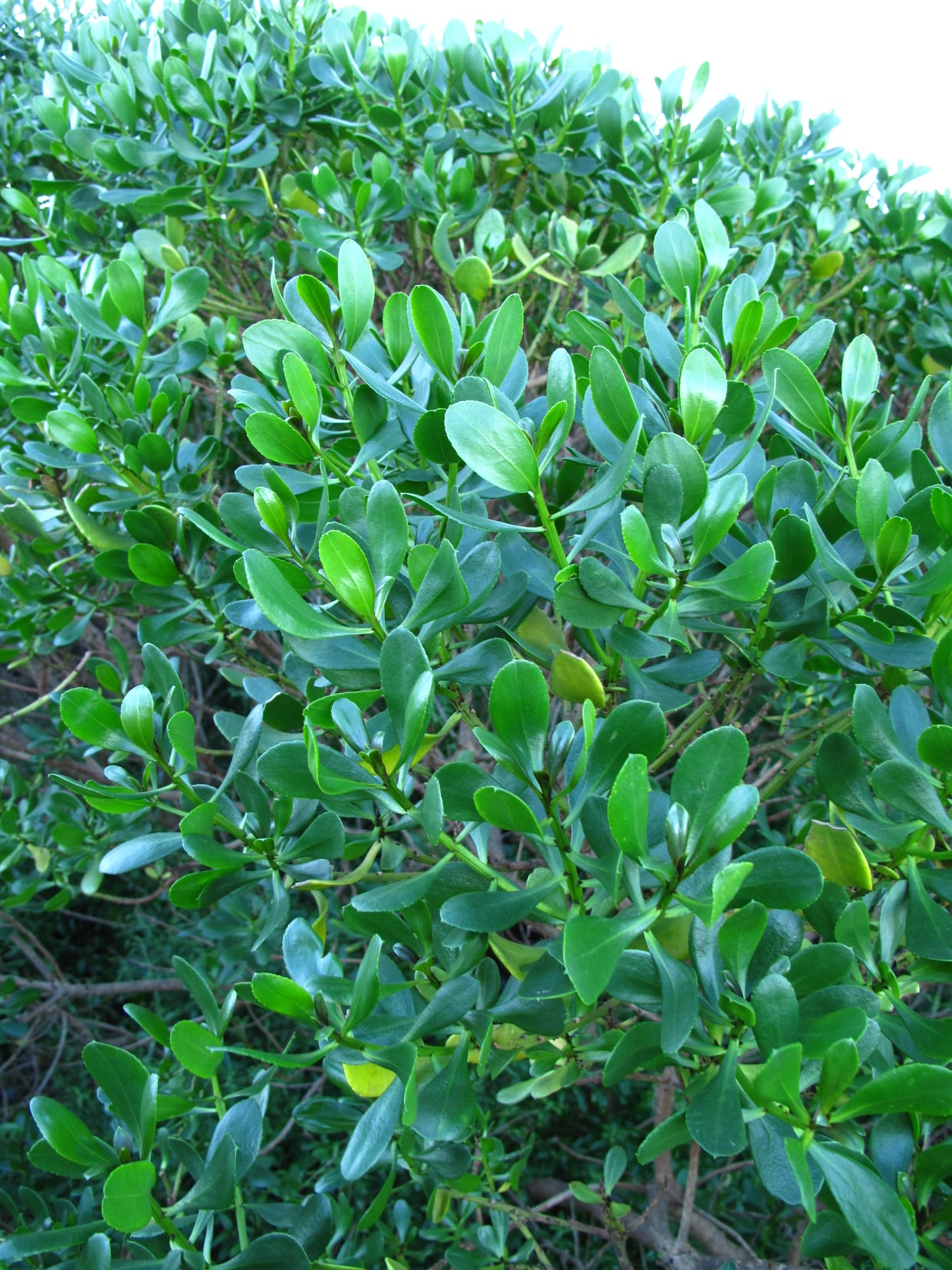
Sydney Wildlife: Registrations For The Next Rescue And Care Course Are Now Open - Commences June 19, 2021
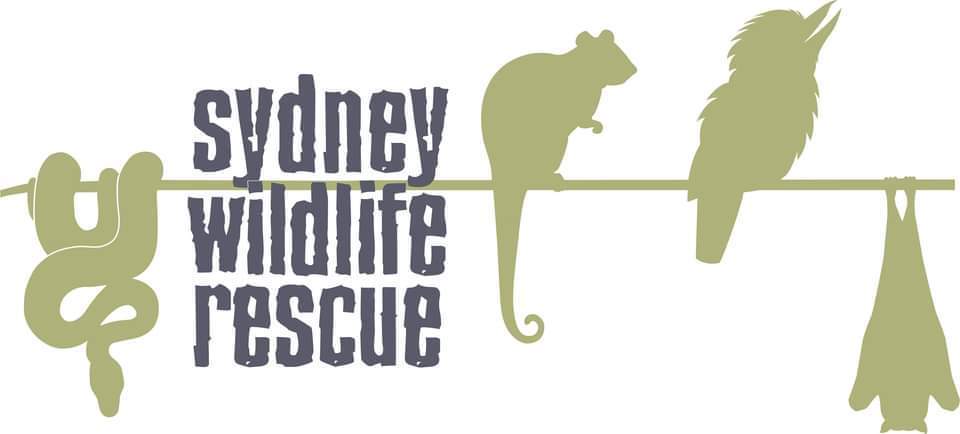
ORRCA News: 2021 Census Day And 2021 Art Comp.
- * Create a cetacean inspired artwork of any description
- * Like the ORRCA FB page and/or Instagram Page
- * Post artwork publicly via your Facebook or Instagram account
- WITH the hashtag #orrcacreatesasplash2021 AND the age
- category they are entering (12 years and under, 13-18 years, 19 years and over)
- * You are able to submit multiple entries
- * Posts needs to be shared publicly so that the ORRCA team can
- see artwork and hashtag
- * All entries must be submitted by 5 June 2021
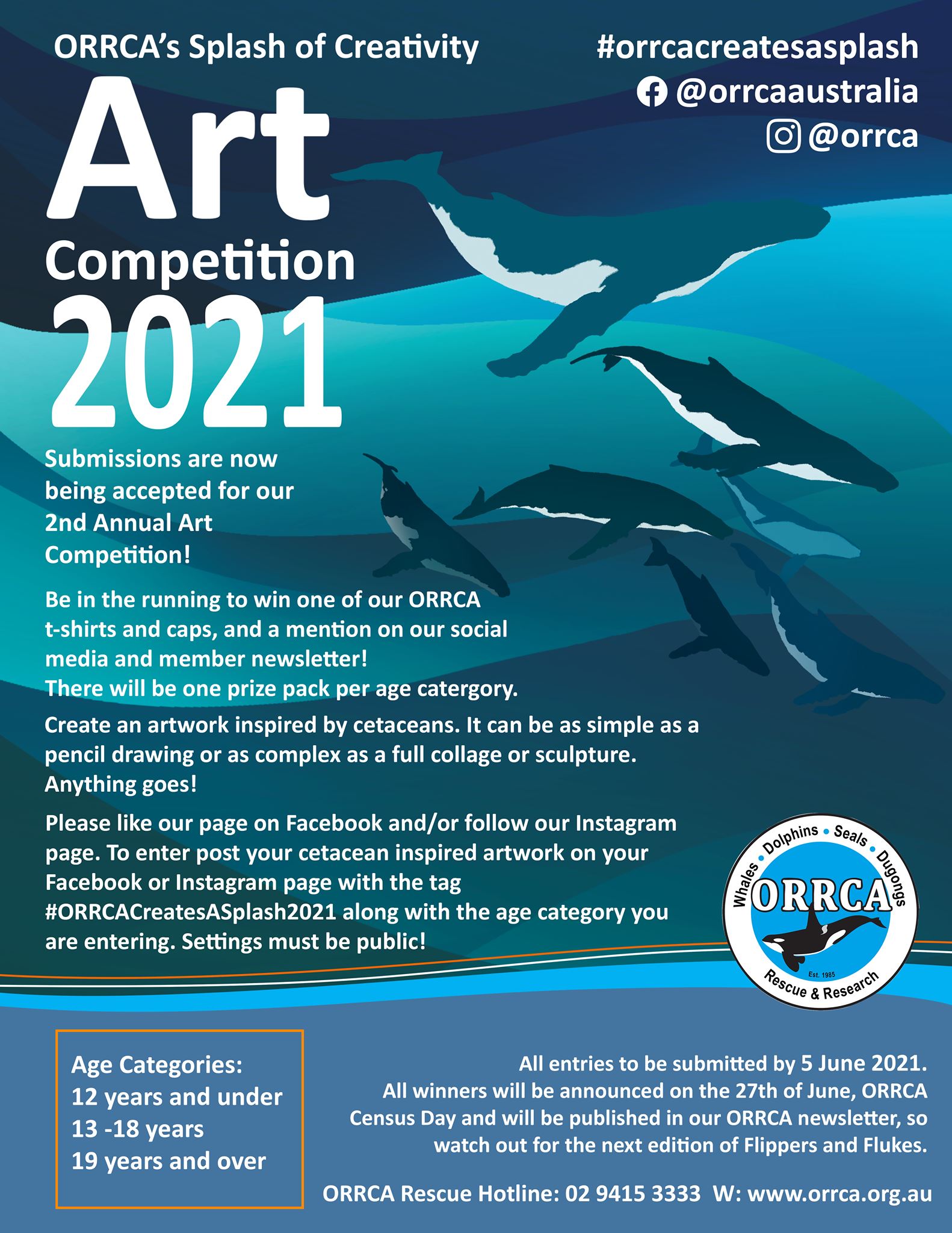
ORRCA Census Day 2021: Sunday June 27 2021
- This is a FREE event for all to join in.
- From sun up to sun down.
- Record all your sightings from your favourite whale watching location using an ORRCA data sheet and sending it into the team at the end of the day.
- Email orrcacensusday@gmail.com for all the details as they unfold.
Newport Community Garden Autumn Harvest

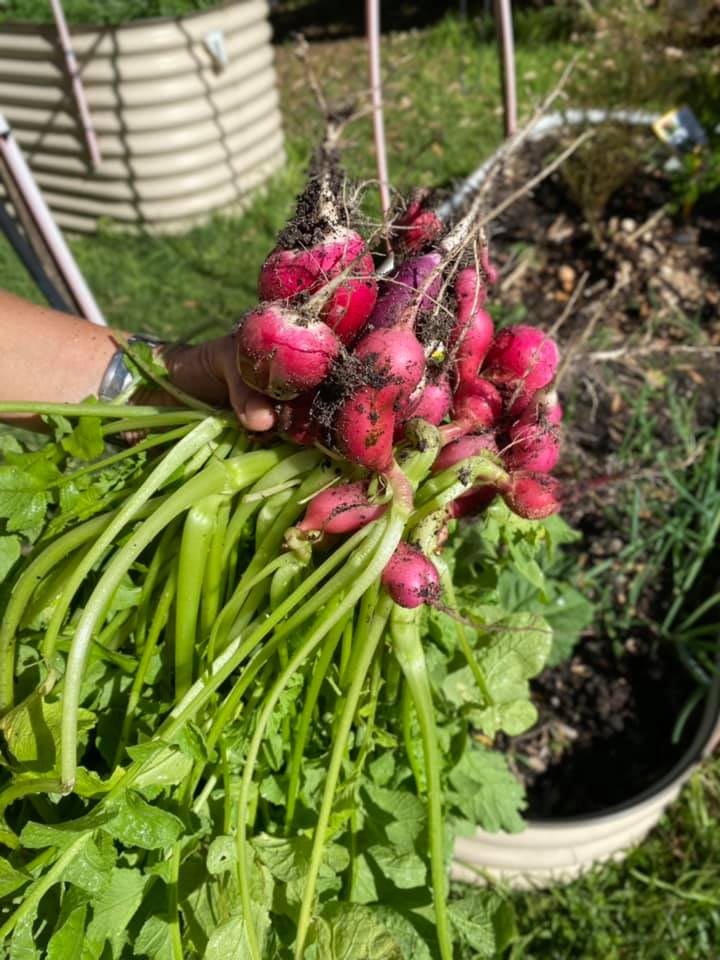
Friends Of Narrabeen Lagoon Catchment: Next Forum
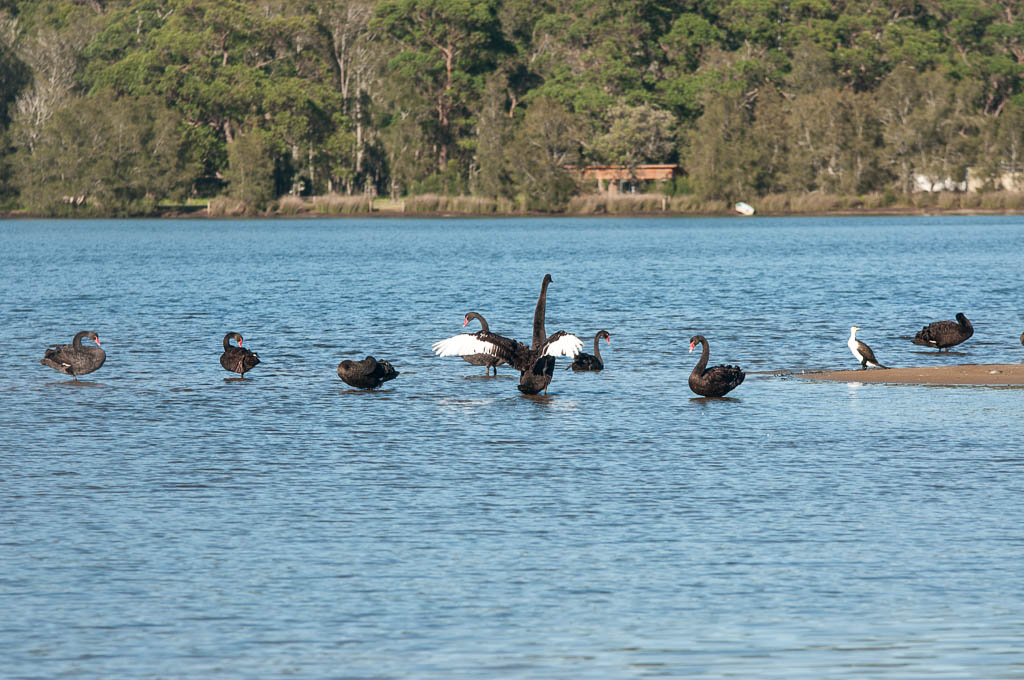
Avalon Community Garden
Avalon Community Garden’s primary purpose is to foster, encourage and facilitate community gardening in Pittwater on a not-for-profit basis.
The garden was started in 2010 by a group of locals who worked in conjunction with the support of Barrenjoey High School to develop a space that could be used by the local community, to grow
vegetables, herbs, plants and flowers, and practice sustainable gardening techniques to benefit its members and the community overall.
The garden has been very successful and has grown and developed since its inception, in terms of its footprint, infrastructure, variety of produce and diversity of members. The garden welcomes new members all year round. Levels of contribution range from multiple times a week, to once a month. Your contribution is always welcome, and it is acknowledged people will have varying levels of commitment.
We encourage you to join and start enjoying the following benefits associated with community gardening:
They provide benefits for individuals and for the community as a whole. Community gardens provide education on gardening, recycling and sustainable use of natural resources.
They develop community connections and provide a means of engaging youth, children, the elderly and the disabled and otherwise marginalised individuals in mutually enjoyable and rewarding activities, thus helping to develop more functional and resilient communities.
People involved in community gardens say they improve wellbeing by increasing physical activity and reducing stress, providing opportunities to interact meaningfully with new friends, give time for relaxation and reflection as well as an opportunity to improve their interconnectedness with nature.
To get involved take a look around the site, join the Facebook group and come along and visit on a Sunday morning between 10 and 12 at the garden within Barrenjoey High School on Tasman Road, North Avalon.
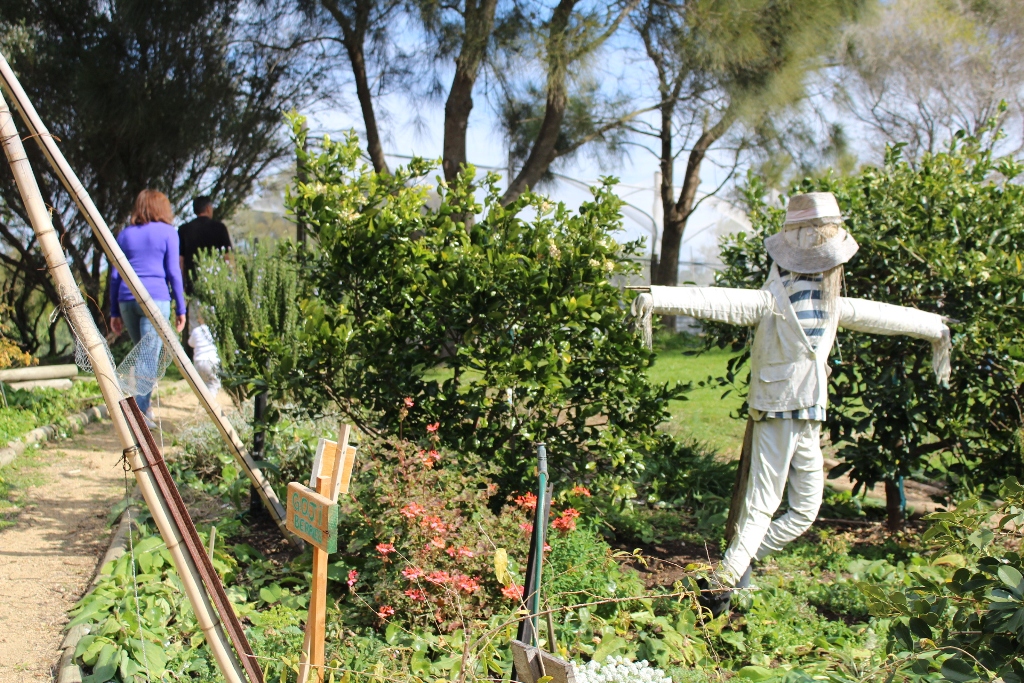
Bushfire Conference June 2021
NSW Government To Strengthen Planning For Natural Hazards: Feedback Wanted
New guidelines to help communities and councils plan for natural hazards such as bushfires, drought and floods have been released today for public feedback - until June 8, 2021.
In releasing the draft Strategic Guide to Planning for Natural Hazards in NSW, Minister for Planning and Public Spaces Rob Stokes said the recent flooding which devastated parts of the state emphasised the need to plan strategically for natural hazards.
“Our state is the best place to live in Australia but with its natural beauty comes challenges,” Mr Stokes said.
“In the last few years we’ve experienced some of the worst drought, bushfires and flooding on record so it’s important we continually learn and adapt how we plan for these hazards.
“This draft guide supports the findings of the Bushfire Royal Commission that we need to better address legacy risk in our communities by making sure that strategic land[1]use planning builds resilience to known hazards.”
Minister for Police and Emergency Services David Elliott said NSW has been hit by a series of natural disasters in recent years and the NSW Government is working to reduce the impact and costs of extreme weather events on communities where possible.
“Between 2009 and 2019, NSW was affected by 198 declared natural disasters which resulted in significant losses and cost the State approximately $3.6 billion per year,” Mr Elliott said.
“That’s why we need to future proof our regions rather than reacting to disasters when they occur – prevention and mitigation are critical.”
The draft document comprises eight guiding principles:
- Consider natural hazard risk early
- Protect vulnerable people and assets
- Adopt an all-hazards approach
- Involve the community in conversations about risk
- Plan for emergency response and evacuation
- Be information driven· Plan to rebuild the future, not the present
- Understand the relationship between natural processes and natural hazards
The NSW Government’s flood prone planning package will be finalised shortly.
For more information and to provide feedback on the draft natural hazard guide visit planning.nsw.gov.au/Natural-hazards
National Strategy To Protect Threatened Species
- Risk of extinction (Prioritising species and places under severe and imminent threat)
- Multiple benefits (Prioritising species and places where recovery action will benefit other species)
- Feasibility and effectiveness (Prioritising species and places where action can make a difference and is cost-effective)
- Importance to people (prioritising people and places of cultural significance)
- Uniqueness (Prioritising species and places that are unlike any other)
- Representativeness (Achieving balance in selected species and places)
- Mitigating new and established threats
- Conserving, restoring and improving habitat
- Emergency preparedness and response
- Climate change adaption and resilience
Australia's threatened species plan sends in the ambulances but ignores glaring dangers
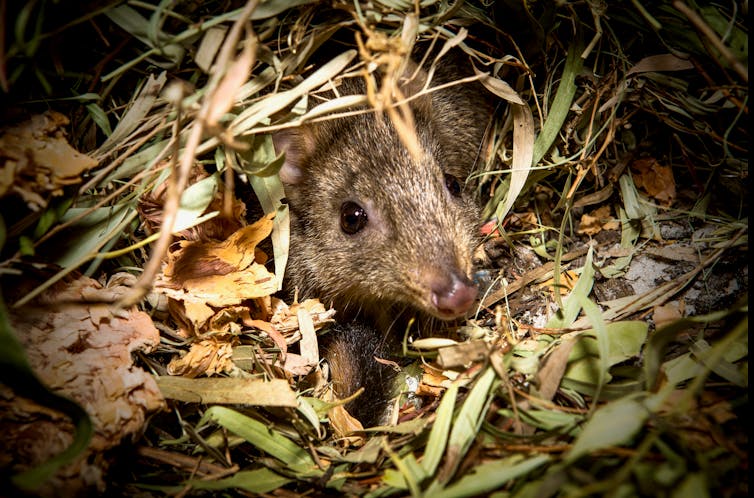
Australia is unquestionably in the midst of an extinction crisis. Some 34 native mammal species have been driven to extinction since European invasion, and threatened species and ecological communities now number more than 1,900.
On Friday, federal environment minister Sussan Ley released Australia’s second Threatened Species Strategy – a roadmap for combating threats to native plants, animals and ecological communities.
The ten-year plan builds on the first strategy launched in 2015, and contains welcome changes. But there remain serious questions about how the plan will be funded and implemented – and quite possibly undermined by other federal government policies.
In essence, the strategy sends a few extra ambulances to the bottom of the cliff, rather than installing a fence at the top to stop species tumbling over.
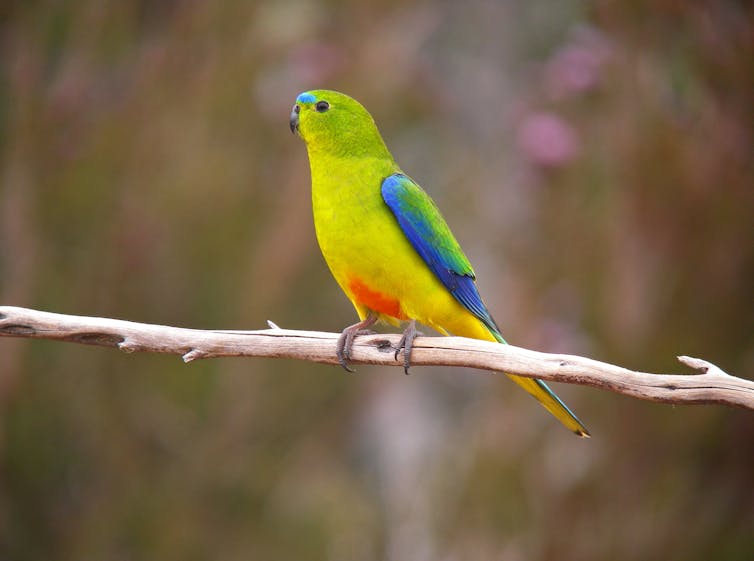
First, The Good News
It would be useful when assessing the new strategy to know how the previous one measured up. Unfortunately, federal environment officials have not yet released the last report card for that strategy, which makes it hard to identify what worked and what didn’t.
Nonetheless, the second strategy differs from the first in important ways.
The first strategy was criticised for its heavy focus on feral cats. Other problems which are just as (and often more) threatening to vulnerable species were not given the same attention. These include altered fire regimes, land clearing and other invasive species such as weeds and rabbits. Importantly, the new strategy recognises a greater number of key threats to wildlife and their habitats.
It also expands the number of actions for threatened species recovery from four to eight. Such actions may include tackling weeds and diseases, relocating species and identifying climate refuges.
The first strategy was rightly questioned for a somewhat myopic focus on 20 mammal, 20 bird and 30 plant species. It also lacked a transparent and evidence-based process for determining how a species was selected as a priority.
The new strategy could expand the types of species targeted for conservation to include fish, amphibian, reptile and invertebrate species. Also, the process for prioritising species for action promises to be more rigorous – assessed against six principles supported by science and existing conservation frameworks.
Significantly, priority places in need of conservation will likewise be assessed through a formal process. This is welcome if it ultimately protects habitats and broader ecosystems, an essential element of avoiding species extinctions.
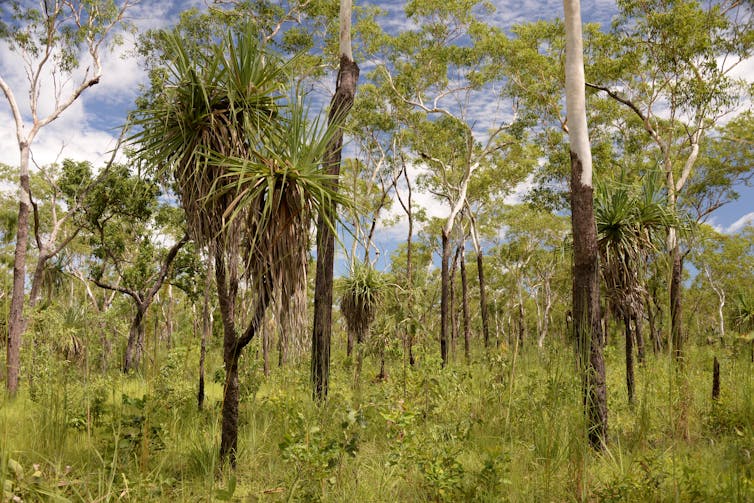
But Challenges Remain
The strategy talks of improving species trajectories, but it’s unclear what would constitute success in this regard.
If a threatened species’ population numbers were declining at a slower rate due to an intervention, would that intervention be deemed a success? Will successful actions be attributed to the strategy (and, by association, the federal government), even if they were entirely funded by philanthropic or community efforts?
Scientists have gone to great lengths to improve our knowledge about trends in threatened bird, mammal and plant species for which monitoring programs exist. However data for threatened species remains deficient, due to funding cuts for monitoring and associated infrastructure.
This means measuring progress on the strategy will be difficult, because we simply don’t have enough reliable data. And the strategy does not appear to remedy this situation with funding.
The strategy makes references to six important principles to guide decisions on which species are to be prioritised for assistance. These include how close a species is to extinction, a species’ ‘uniqueness’, the likelihood an intervention will work and whether the species is culturally significant. But these principles should not be applied in isolation from each other.
For example, it may be more cost efficient to save species with both a high chance of extinction and relatively cheap and effective interventions. But the most unique species may not be the cheapest to save, and the most endangered species may not be the species of greatest importance to one sector of the community.
So prioritisation may require trade-offs between different principles. There is no magic “one size fits all” solution, but excellent scientific guidance exists on how to keep this process objective, transparent and, most of all, repeatable.
The strategy acknowledges major drivers of biodiversity decline and extinction, including climate change, habitat destruction and pollution. However, nowhere is there an explicit declaration that to conserve or recover our species and environments we must tackle the underlying causes of these drivers.
The strategy also fails to acknowledge the key role legislation plays in reining in – or enabling – threats such as land clearing. An independent review earlier this year confirmed federal environment laws are failing abysmally. But fundamental recommendations stemming from the review, such as independent oversight and adequate resourcing, are not included in the strategy.
Read more: A major report excoriated Australia's environment laws. Sussan Ley's response is confused and risky
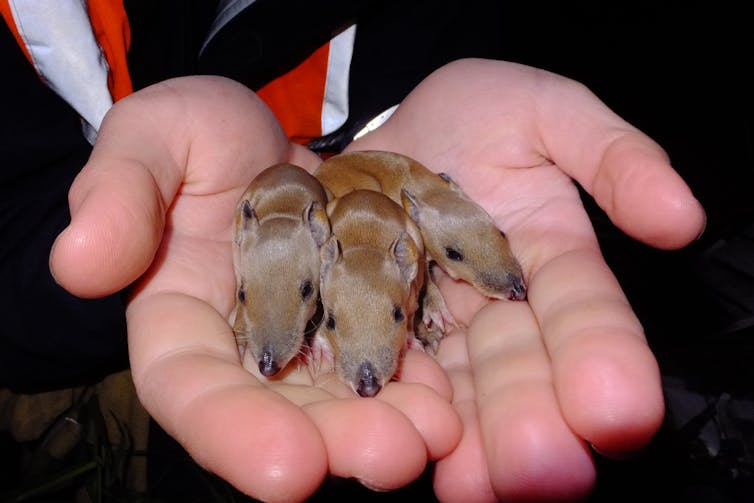
A Better Deal For Nature
To be effective, the strategy must chart a path to effective environmental law reform.
And saving our threatened species and ecosystems shouldn’t be seen as a cost, but rather a savvy investment.
Increased and targeted funding for on-ground actions, such as weed and pest animal control, species re-introductions, and Indigenous ranger programs, could generate many thousands of jobs. Such measures would also boost local economies and support industries such as tourism.
A 2019 study found Australia’s listed threatened species could be recovered for about A$1.7 billion a year.
The Morrison government recently announced it would spend A$7 billion setting up a military space division to better protect satellites from attack.
What’s our best defence for an uncertain future? We argue it’s ensuring Earth’s life support systems, including its remarkable species and landscapes, are also protected.
Read more: Research reveals shocking detail on how Australia's environmental scientists are being silenced ![]()
Euan Ritchie, Professor in Wildlife Ecology and Conservation, Centre for Integrative Ecology, School of Life & Environmental Sciences, Deakin University; Ayesha Tulloch, DECRA Research Fellow, University of Sydney, and Don Driscoll, Professor in Terrestrial Ecology, Deakin University
This article is republished from The Conversation under a Creative Commons license. Read the original article.
Remotely Operated Underwater Vehicles Protecting Australia From Exotic Marine Pests
Australia’s First Inspector-General Of Water Compliance For The Murray-Darling Basin
Roundtable To Find Answers To Unfashionable Problems
- Australia is reported to have the second highest consumption of textiles per capita in the world (second to the United States)
- Each Australian consumes an average of 27 kg of new textiles per year and disposes an average 23kgs of textiles to landfill each year
- According to the 2020 National Waste Report, in 2018-19 Australia generated 780,000 tonnes of textile waste. Only 7% of this waste was recycled (mostly exports) with the remaining 93% sent to landfill
- In 2019-20, Australia exported 47,320 tonnes of textile waste. Of this, 99% was worn clothing and other worn textiles. The top three export destinations were United Arab Emirates (55%), Malaysia (19%) and Pakistan (8%)
- The Federal Government recently boosted funding to National Product Stewardship schemes, committing an additional $5.9 million from the 2021-22 Budget to reduce waste and increase resources recovery.
New Plan To Revitalise Oldest NSW's Park By Installing Mountain Bike Trails
- Royal National Park, Heathcote National Park, Garawarra State Conservation Area Draft Planning Considerations
- Royal National Park, Heathcote National Park and Garawarra State Conservation Area Draft Plan of Management
- Royal National Park, Heathcote National Park and Garawarra State Conservation Area Draft Mountain Biking Plan
A '100% renewables' target might not mean what you think it means. An energy expert explains
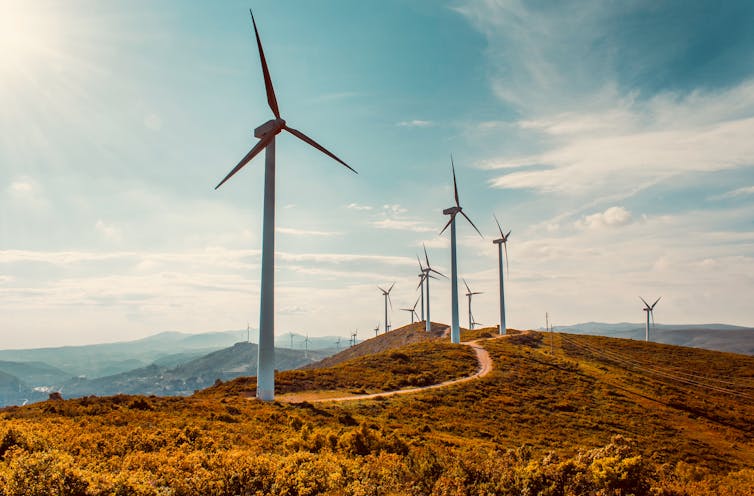
In the global effort to transition from fossil fuels to clean energy, achieving a “100% renewables” electricity system is considered ideal.
Some Australian states have committed to 100% renewable energy targets, or even 200% renewable energy targets. But this doesn’t mean their electricity is, or will be, emissions free.
Electricity is responsible for a third of Australia’s emissions, and making it cleaner is a key way to reduce emissions in other sectors that rely on it, such as transport.
So it’s important we have clarity about where our electricity comes from, and how emissions-intensive it is. Let’s look at what 100% renewables actually implies in detail.
Is 100% Renewables Realistic?
Achieving 100% renewables is one way of eliminating emissions from the electricity sector.
It’s commonly interpreted to mean all electricity must be generated from renewable sources. These sources usually include solar, wind, hydro, and geothermal, and exclude nuclear energy and fossil fuels with carbon capture and storage.
But this is a very difficult feat for individual states and territories to try to achieve.
The term “net 100% renewables” more accurately describes what some jurisdictions — such as South Australia and the ACT — are targeting, whether or not they’ve explicitly said so.
These targets don’t require that all electricity people use within the jurisdiction come from renewable sources. Some might come from coal or gas-fired generation, but the government offsets this amount by making or buying an equivalent amount of renewable electricity.
A net 100% renewables target allows a state to spruik its green credentials without needing to worry about the reliability implications of being totally self-reliant on renewable power.
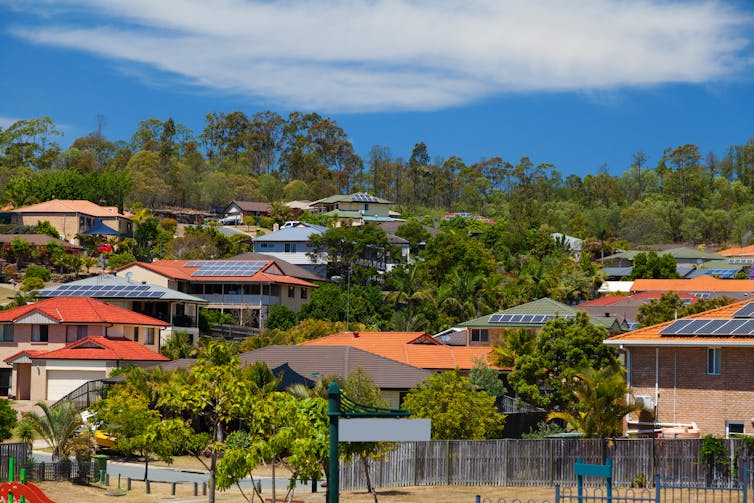
So How Does ‘Net’ 100% Renewables Work?
All east coast states are connected to the National Electricity Market (NEM) — a system that allows electricity to be generated, used and shared across borders. This means individual states can achieve “net 100% renewables” without the renewable generation needing to occur when or where the electricity is required.
Take the ACT, for example, which has used net 100% renewable electricity since October 2019.
The ACT government buys renewable energy from generators outside the territory, which is then mostly used in other states, such as Victoria and South Australia. Meanwhile, people living in ACT rely on power from NSW that’s not emissions-free, because it largely comes from coal-fired power stations.
This way, the ACT government can claim net 100% renewables because it’s offsetting the non-renewable energy its residents use with the clean energy it’s paid for elsewhere.
SA’s target is to reach net 100% renewables by the 2030s. Unlike the ACT, it plans to generate renewable electricity locally, equal to 100% of its annual demand.
At times, such as especially sunny days, some of that electricity will be exported to other states. At other times, such as when the wind drops off, SA may need to rely on electricity imports from other states, which probably won’t come from all-renewable sources.
Read more: More coal-fired power or 100% renewables? For the next few decades, both paths are wrong
So what happens if all states commit to net 100% renewable energy targets? Then, the National Electricity Market will have a de-facto 100% renewable energy target — no “net”.
That’s because the market is one entire system, so its only options are “100% renewables” (implying zero emissions), or “less than 100% renewables”. The “net” factor doesn’t come into it, because there’s no other part of the grid for it to buy from or sell to.
How Do You Get To “200% Renewables”, Or More?
It’s mathematically impossible for more than 100% of the electricity used in the NEM to come from renewable sources: 100% is the limit.
Any target of more than 100% renewables is a different calculation. The target is no longer a measure of renewable generation versus all generation, but renewable generation versus today’s demand.

Tasmania, for example, has legislated a target of 200% renewable energy by 2040. This means it wants to produce twice as much renewable electricity as it consumes today.
But this doesn’t necessarily imply all electricity consumed in Tasmania will be renewable. For example, it may continue to import some non-renewable power from Victoria at times, such as during droughts when Tasmania’s hydro dams are constrained. It may even need to burn a small amount of gas as a backup.
This means the 200% renewable energy target is really a “net 200% renewables” target.
Meanwhile, the Greens are campaigning for 700% renewables. This, too, is based on today’s electricity demand.
In the future, demand could be much higher due to electrifying our transport, switching appliances from gas to electricity, and potentially exporting energy-intensive, renewable commodities such as green hydrogen or ammonia.
Targeting Net-Zero Emissions
These “more than 100% renewables” targets set by individual jurisdictions don’t necessarily imply all electricity Australians use will be emissions free.
It’s possible — and potentially more economical — that we would meet almost all of this additional future demand with renewable energy, but keep some gas or diesel capacity as a low-cost backstop.
This would ensure continued electricity supply during rare, sustained periods of low wind, low sun, and high demand, such as during a cloudy, windless week in winter.
Read more: Carry-over credits and carbon offsets are hot topics this election – but what do they actually mean?
The energy transition is harder near the end — each percentage point between 90% and 100% renewables is more expensive to achieve than the previous.
That’s why, in a recent report from the Grattan Institute, we recommended governments pursue net-zero emissions in the electricity sector first, rather than setting 100% renewables targets today.
For example, buying carbon credits to offset the small amount of emissions produced in a 90% renewable NEM is likely to be cheaper in the medium term than building enough energy storage — such as batteries or pumped hydro dams — to backup wind and solar at all times.
The bottom line is governments and companies must say what they mean and mean what they say when announcing targets. It’s the responsibility of media and pundits to take care when interpreting them.![]()
James Ha, Associate, Grattan Institute
This article is republished from The Conversation under a Creative Commons license. Read the original article.
Wondering if your energy company takes climate change seriously? A new report reveals the answer

A landmark report released last week put coal and gas on notice. For the first time, the International Energy Agency (IEA) declared reaching net-zero emissions by 2050 means no new investments in fossil fuel supply projects.
For Australia – a continent blessed with a bounty of wind and sun – the phasing out of coal and gas investment should be considered a boon. Australia is already deploying wind and solar energy ten times faster than the global average, and still has plenty of unmet renewables potential.
But of course, Australia’s path to a clean energy economy has not been perfectly smooth. A lack of federal leadership on climate policy and a historical dependence on fossil fuels means the IEA’s roadmap presents a big challenge for Australia.
Our latest report released today underscores how big a challenge this is. We assessed Australia’s highest-emitting energy firms and found none were fully or even closely aligned with global climate goals. Just one went even partway, and five appeared to be taking no action at all.
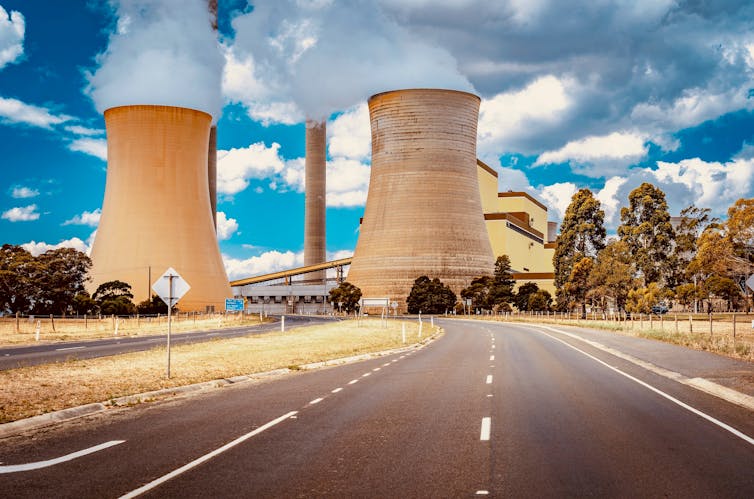
A Poor Showing
Our energy sector report forms part of the Net Zero Momentum Tracker, a project by research organisation ClimateWorks, which works within the Monash Sustainable Development Institute.
We assessed the commitments of Australia’s 20 highest-emitting energy companies against the Paris Agreement goals, which include limiting global temperature rise to well below 2℃, aiming for 1.5℃. The IEA’s latest work shows to reach those goals, the global energy sector must reach net-zero emissions by 2050.
The companies we analysed comprise electricity generators and electricity and gas retailers. Together, they account for almost one-third of Australia’s total annual emissions.
Each company’s commitments were assessed against scenarios we modelled, which map the least-cost trajectories for reducing Australia’s emissions in line with the Paris goals.
We found no large energy company was fully aligned with these trajectories, and most fell well short. Six had set emissions reduction targets and nine others had taken some action to cut emissions.
However, not a single company had commitments that are in line with Australia achieving net-zero emissions by 2050.
Read more: We could be a superpower: 3 ways Australia can take advantage of the changing geopolitics of energy

How Your Energy Company Fares
The 20 companies we assessed account for almost 90% of Australia’s electricity emissions. Together, they generate more than 70% of Australia’s electricity supplies.
French-owned energy generator and retailer ENGIE was the only company with activities on a trajectory supporting Australia’s Paris-aligned transition, because of a target that aims to reduce some of its emissions by 2030. But the target does not cover the majority of ENGIE’s emissions, so the company has much more work to do.
Fourteen companies had a mix of targets or actions we assessed as not aligned with the Paris goals. They are:
- AGL
- APT Pipelines
- ATCO
- CS Energy
- CK William
- Delta
- EnergyAustralia
- Origin
- Pioneer Sail
- Snowy Hydro
- Stanwell
- Synergy
- Territory Generation
- TransAlta.
And these five companies had no disclosed emissions reduction activities:
- Arrow Energy
- Bluewaters Power 1&2
- NewGen Kwinana
- NRG Gladstone Operating Services
- OzGen.
Read more: Government-owned firms like Snowy Hydro can do better than building $600 million gas plants

The Big Four Emitters
AGL, EnergyAustralia, Stanwell and Origin are the biggest emitters in Australia’s electricity sector. Collectively, they’re responsible for more than half the sector’s emissions, and so have a particular responsibility to act.
When energy companies talk about reducing their greenhouse gas emissions, they do so in terms of scope 1, 2 and 3 emissions.
Scope 1 covers emissions released to the atmosphere as a direct result of company activity, such as burning coal or gas to produce electricity. Scope 2 covers the emissions created to produce the electricity a company purchases.
Scope 3 emissions are those outside the companies’ direct control. They include upstream processes such as the extraction, production and transport of fuel used to power their operations, and downstream activities such as the distribution and use of gas sold to consumers.
Origin aspires to achieve net-zero emissions by 2050 and has set interim targets to reduce its scope 1, 2 and 3 emissions.
AGL and EnergyAustralia have committed to achieve net-zero operational (scope 1 and 2) emissions by 2050, but have no interim emissions reduction targets.
Stanwell, which operates two of Queensland’s largest coal-fired generators, has no emissions reduction targets.

A Rapid Renewables Shift
Our earlier research shows that under scenarios compatible with the Paris Agreement, renewables make up 70% of electricity generation by 2030. Coal and gas is phased out of Australia’s electricity mix as soon as 2035.
The energy sector is crucial if Australia is to meet the Paris climate goals. Thanks to renewable energy, the sector enjoys some of the easiest and cheapest emissions reduction opportunities. And a zero-emissions energy sector would also help other sectors such as transport, buildings and industry to decarbonise.
Australia’s energy sector has made progress on emissions in recent years. Three-quarters of the energy companies we assessed have implemented wind and solar energy projects. And overall, renewable energy was responsible for almost 28% of Australia’s total electricity generation in 2020.
However our report shows change is not happening fast enough to put Australia on a timely path to net-zero emissions.
At a federal level, the Renewable Energy Target, which ended last year, drove the clean energy shift. New federal policies are now needed to bolster ambitious state and territory policies. This would enable energy market operators and investors to plan a transition aligned with the Paris goals.
Read more: International Energy Agency warns against new fossil fuel projects. Guess what Australia did next? ![]()
Anna Malos, Australia - Country Lead, ClimateWorks Australia and Coral Bravo, Senior Analyst, ClimateWorks Australia
This article is republished from The Conversation under a Creative Commons license. Read the original article.
Big Battery To Help Power NSW Schools And Hospitals
May 25, 2021
A 100-megawatt battery will help to power schools, hospitals and Government buildings across NSW under the state’s new electricity supply contract. As part of the $3.2 billion 10 year contract, awarded to Shell Energy and Edify, a 100-megawatt battery will be built alongside the Darlington Point Solar Farm in the Riverina, providing critical dispatchable electricity prior to the closure of the Liddell Power Station.
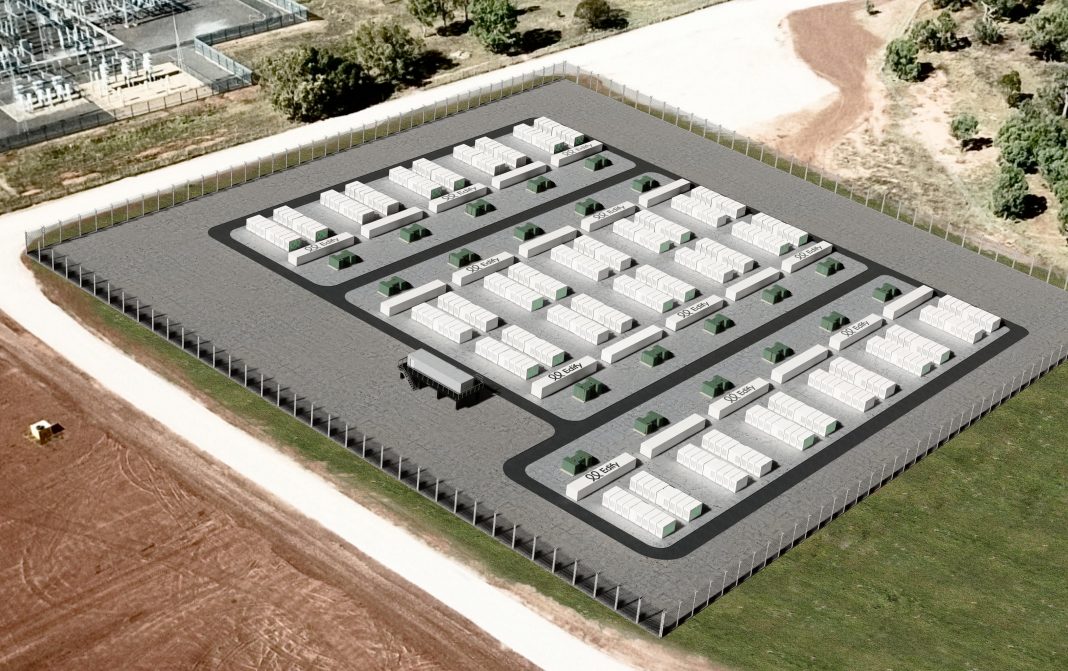
Artist's impression of Riverina energy storage system Credit: DPIE
Energy Minister Matt Kean said the deal delivers great value for money and electricity security for the people of NSW.
“The NSW Government is the second biggest energy customer in the state and we are using our purchasing power to leverage new dispatchable capacity to help power our schools, hospitals, traffic lights and tunnels,” Mr Kean said.
“This battery will help to keep the lights on and keep costs down during peak energy periods, and support more renewable energy to come online.”
Shell Energy CEO Greg Joiner said the NSW Government has been a longstanding and valued customer and is proud to be partnering with them and Edify to bring this energy solution to the market.
“Partnerships are key to delivering solutions in a complex energy transition and we’re pleased to be delivering innovative power solutions that bring investment and contribute to a cleaner and more resilient power system in NSW,” Mr Joiner said.
“Providing products and services that help large energy users decarbonise and meet their emissions goals is a key focus for us in assembling the building blocks of a cleaner energy system in Australia.”
Edify CEO John Cole said batteries are earning their place as a valued capacity solution to secure dispatchable renewable energy for consumers, businesses and Government.
“With our successful track record in forming partnerships to deliver storage projects, we are excited to head back into the Riverina community and continue our work with Shell Energy and the NSW Government to make this innovative project a reality,” Mr Cole said.
The battery, to be built by early 2023 and operated by Edify, will support up to 35 local jobs during the construction phase and will mitigate concerns around supply shortages related to the closure of the Liddell Power Station.
The new contract will commence from July 2022, when existing contracts expire.
$870,000 Upgrade For Popular The Ruins Campground In Booti Booti National Park
May 21, 2021
Campground amenities at The Ruins campground in Booti Booti National Park are being upgraded to improve disabled access and better cater for families, thanks to the NSW Government's investment in National Park's visitor infrastructure.
National Parks and Wildlife Service Manning Great Lakes Area Manager Steve Smith said that while the facilities at the popular campsite had been serving national park visitors well for more than 35 years, it was time to bring the campground into the 21st century.
"We've begun construction on a 300m2 environmentally sustainable campground amenities building and a new camp kitchen" said Mr Smith.
"The brand-new amenities building will feature two accessible bathrooms, family and baby change facilities, instantaneous hot water, low voltage lighting and a coded electronic door access system.
"With up to 600 visitors able to camp at this beach-side campground at any one time, these new facilities will increase capacity, improve disabled access and better cater for families in an energy-efficient and environmentally-friendly way," said Mr Smith.
The Ruins campground is nestled between the spectacular Seven Mile Beach and Wallis Lake in Booti Booti National Park. The park is home for more than 210 species of birds, including the endangered Little Tern and Pied Oystercatcher.
Construction is expected to be completed in September 2021, weather permitting.
The Ruins Campground will remain open during the construction period, however, approximately 50 percent of camp sites in the campground and the BBQ area adjacent to the amenities building will be closed to ensure public safety. The beachside amenities building will be open providing shower and toilet facilities for campers.
Visitors can make a booking to camp at The Ruins campground during the construction period or post-completion in September by visiting the NPWS website.
Ensure you check the Local Alerts for more details and project updates before you visit.
Win For Water: Adani Faces Water Woes Following Court Victory For Communities
May 25, 2021
The Lock the Gate Alliance has stated it welcomes today’s Federal Court ruling that the Morrison Government should have applied the “water trigger” to Adani’s North Galilee Water Scheme.
The scheme would suck up to 12.5 billion litres of water each year via a 150km pipeline from the Suttor River for use in the Carmichael coal mine.
“This is a setback for Adani and proof the government has mishandled the assessment process for the company’s destructive Carmichael coal mine,” said Lock the Gate Alliance Queensland spokesperson Ellie Smith.
“This means if Adani wants to continue with its North Galilee Water Scheme it will have to go back to the drawing board and submit it to a full and rigorous assessment.
“This is an important outcome for landholders and communities in Central Queensland who rely on the water Adani wanted to take for its polluting coal mine.
“This decision exposes the Morrison Government and its efforts to ram through the Adani project at all cost, even ignoring their own experts at the Department of Agriculture and Water Resources who recommended that the water trigger should have been applied.
“This ruling thankfully proves the Morrison Government made the wrong decision, and now sets a precedent for other large coal and coal seam gas projects planned across Queensland and the nation.
“Lock the Gate Alliance commends the Australian Conservation Foundation and the Environmental Defenders Office for their dogged pursuit of this matter through the courts.”
Fly infertility shows we're underestimating how badly climate change harms animals

Evidence of declining fertility in humans and wildlife is growing. While chemicals in our environment have been identified as a major cause, our new research shows there’s another looming threat to animal fertility: climate change.
We know animals can die when temperatures rise to extremes they cannot endure. However, our research suggests males of some species can become infertile even at less extreme temperatures.
This means the distribution of species may be limited by the temperatures at which they can reproduce, rather than the temperatures at which they can survive.
These findings are important, because they mean we may be underestimating the impacts of climate change on animals – and failing to identify the species most likely to become extinct.

Feeling The Heat
Researchers have known for some time that animal fertility is sensitive to heat stress.
For example, research shows a 2℃ temperature rise dramatically reduces the production of sperm bundles and egg size in corals. And in many beetle and bee species, fertilisation success drops sharply at high temperatures.
High temperatures have also been shown to affect fertilisation or sperm count in cows, pigs, fish and birds.
However, temperatures that cause infertility have not been incorporated into predictions about how climate change will affect biodiversity. Our research aims to address this.
Read more: Male fertility: how everyday chemicals are destroying sperm counts in humans and animals
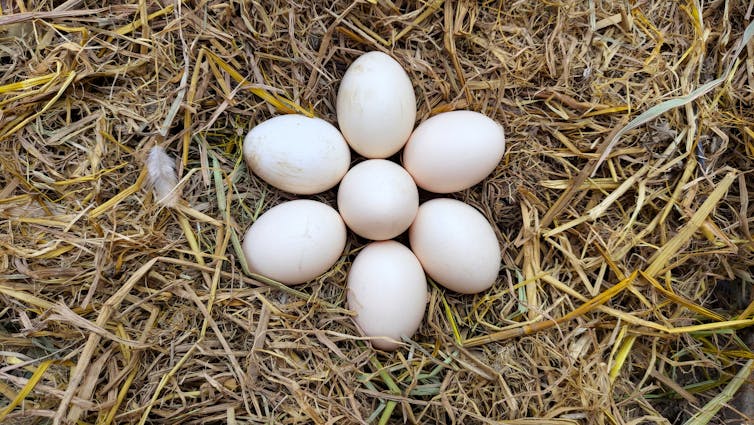
A Focus On Flies
The paper published today involved researchers from the United Kingdom, Sweden and Australia, including one author of this article. The study examined 43 species of fly to test whether male fertility temperatures were a better predictor of global fly distributions than the temperatures at which the adult fly dies - also known as their “survival limit”.
The researchers exposed flies to four hours of heat stress at temperatures ranging from benign to lethal. From this data they estimated both the temperature that is lethal to 80% of individuals and the temperature at which 80% of surviving males become infertile.
They found 11 of 43 species experienced an 80% loss in fertility at cooler-than-lethal temperatures immediately following heat stress. Rather than fertility recovering over time, the impact of high temperatures was more pronounced seven days after exposure to heat stress. Using this delayed measure, 44% of species (19 out of 43) showed fertility loss at cooler-than-lethal temperatures.
Read more: The 50 beautiful Australian plants at greatest risk of extinction — and how to save them
The researchers then matched these findings to real-world data on the flies’ distribution, and estimated the average maximum air temperatures the species are likely to encounter in the wild. They found the distribution of fly species is linked more closely to the effects of high temperature on male fertility than on temperatures that kill flies.
These fertility responses are crucial to species survival. A separate study led by one author of this article, using simulated climate change in the laboratory, showed experimental populations of the same flies become extinct not because they can’t survive the heat, but because the males become infertile. Species from tropical rainforests were the first to succumb to extinction.
The prediction that tropical and sub-tropical species may be more vulnerable to climate change is not new. But the fertility findings suggest the negative impact of climate change may be even worse than anticipated.
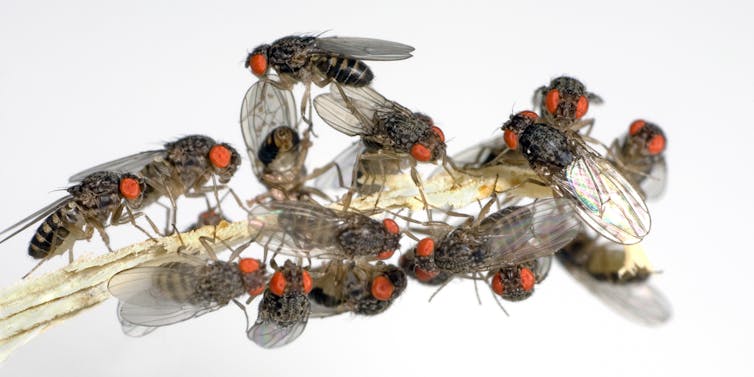
What Does All This Mean?
Some animals have adapted to minimise the effect of high temperature on fertility. For instance, it’s thought testes in male primates and humans are externally located to protect the developing sperm from excessive heat.
As the planet warms, animals may further evolve to withstand the effects of heat on fertility. But the speed at which a species can adapt may be too slow to ensure their survival. Our research has shown both tropical and widespread species of flies could not increase their fertility when exposed to simulated global warming, even after 25 generations.
A study involving beetles also indicates fertility damage from successive heatwaves can accumulate over time. And more work is needed to determine how other stressors such as salinity, chemicals and poor nutrition may compound the fertility-temperature problem.
Whether our findings extrapolate to other species, including mammals such as humans, is not yet clear. It’s certainly possible, given evidence across the animal kingdom that fertility is sensitive to heat stress.
Either way, unless global warming is radically curbed, animal fertility will likely decline. This means Earth may be heading for far more species extinctions than previously anticipated.
Read more: The 1.5℃ global warming limit is not impossible – but without political action it soon will be ![]()
Belinda van Heerwaarden, Future Fellow, The University of Melbourne and Ary Hoffmann, Professor, School of BioSciences and Bio21 Institute, The University of Melbourne
This article is republished from The Conversation under a Creative Commons license. Read the original article.
Going electric and banning new petrol-powered cars could be Australia’s next big light bulb moment

In 2007 Malcolm Turnbull turned off an industry’s life support without blinking.
The industry made light bulbs, of the traditional kind; so energy-inefficient they lost most of it as heat.
“A normal light bulb is too hot to hold — that heat is wasted, and globally represents millions of tonnes of carbon dioxide that needn’t have been emitted,” he explained.
From February 2009 it became illegal to import the traditional pear-shaped globes, while from November that year it became illegal to sell them.
It was a world-first, announced by Turnbull as environment minister and sanctioned by his prime minister John Howard.
The European Union followed, and then, some years later, China.
Globally, electric lighting generated emissions equal to 70% of those from cars. Australia’s switch cut emissions by an estimated 4 million tonnes per year.

Turnbull was able to do it because Australia no longer made light globes.
There was no domestic industry — and no jobs — to protect.
Australia stopped making cars in 2017. The thousands of workers who used to assemble cars in Australia no longer have those jobs.
Which means there’s no car industry to protect.
We have the opportunity to do to traditionally-powered cars what we did to incandescent light bulbs.
And the need. We’ve all but committed ourselves to net-zero emissions by 2050.
In a landmark report released last Tuesday, the International Energy Agency said the path to net-zero by 2050 was narrow and extremely challenging, requiring governments to “take action this year and every year after so that the goal does not slip out of reach”.
Many of the 400 or so milestones it set out are challenging for Australia, among them no new coal mines or mine expansions from this year, and the closure of almost all of Australia’s coal-fired power stations by the end of this decade.
But one of the milestones ought to be easy.
It’s no new sales of internal combustion cars by 2035.
The Rest Of The World Is Racing Ahead
As a step along the way, the agency wants two-thirds of all new cars sold to be petrol-free by 2030. Australia, with no vehicle production industry to care about, ought to get there sooner.
Norway has promised no new petrol car sales by 2025; Denmark, the Netherlands, Ireland and Israel by 2030; and California and the United Kingdom by 2035, a target the UK has brought forward from 2040.
In addition, the European Union is imposing manufacturer-specific emissions targets, which will force each one to either sell a greater proportion of non-petrol vehicles or make the ones they do sell much more efficient.
Read more: Costly, toxic and slow to charge? Busting electric car myths
Manufacturers are getting in early. Honda says it will sell only electric and hybrid vehicles in Europe starting in 2022, three years earlier than previously planned. Volvo says 50% of its worldwide sales will be fully electric by 2025 and the rest hybrids.
Like the transitions to colour TV, automatic car windows, automatic transmissions and transistor radios, the shift will be one way. When production lines are retooled, there will be no turning back.
Moving quickly would do more than help Prime Minister Scott Morrison produce a credible roadmap to take to Glasgow climate talks in November.
It would enable us to avoid becoming a dumping ground for the dirtier, more polluting vehicles that can’t be sold elsewhere while the changeover is underway.
Switching Soon Would Save Us Money
And it would save the government money. It has just committed to pay up to A$2 billion to keep Australia’s two remaining oil refineries open until 2027.
Without the payments, Ampol might have closed Lytton in Queensland (it was weighing up doing so) and Viva Energy refinery might have closed its loss-making refinery at Geelong.
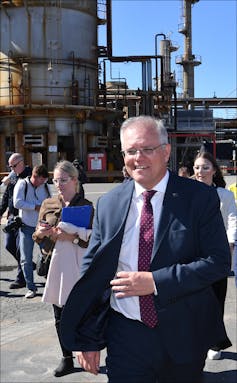
While both have accepted the money, Ampol has unveiled plans to test the production of solar-powered hydrogen on its site at Lytton and Viva Energy is planning a solar farm on its site at Geelong.
Most of Australia’s petrol is imported, much of it from Singapore, meaning little would be lost if Australia’s refineries closed.
The Australian-produced fuel is dirtier than the imported fuel, something the Australian government promised to fix this month by paying Australia’s plants to make the ultra-low sulphur petrol the rest of the world switched to years ago.
If a ban on imports of petrol-powered cars wouldn’t much hurt Australia’s reluctant refiners, it might hurt petrol stations, but not much.
Australia’s service stations are in large measure retail convenience stores. They try to maximise “basket size”. Ampol plans to turn the petrol side of the business into a recharge and refuelling network for electric and hydrogen vehicles.
Mechanics Would Lose Jobs
The much-larger industry at risk from a switch to electric vehicles is car maintenance. The Bureau of Statistics counts 352,200 automotive and engineering trades workers, almost all of them male and full time.
That a switch to low-maintenance electric vehicles would shrink their industry is unfortunate for them, but inevitable. Propping up their industry by delaying the transition would only encourage more young people into jobs with limited futures.

When Australia switched from valve to transistor-operated TV sets in the 1970s, an army of “television repair men” was thrown out of business, along with their vans and two-way radios.
Most of them stayed in the workforce doing things we needed.
To have kept using sets requiring maintenance just to have kept them in work would have been an insult to them and us.
And while Australia’s switch away from incandescent globes was problematic (many of us liked the yellowish glow we’d become used to) the switch to electric cars is looking positively joyous.

This week Crikey pointed to a video in which the Queensland MP Bob Katter gets his first taste of a Tesla as it accelerates from zero to 100 kilometres per hour in just over three seconds.
“Yeehaw!” he yells. “This is so exciting.”
Australians usually embrace the future. At times we’ve been ahead of it.
Read more: International Energy Agency warns against new fossil fuel projects. Guess what Australia did next? ![]()
Peter Martin, Visiting Fellow, Crawford School of Public Policy, Australian National University
This article is republished from The Conversation under a Creative Commons license. Read the original article.
Bushcare In Pittwater
Where we work Which day What time
Avalon
Angophora Reserve 3rd Sunday 8:30 - 11:30am
Avalon Dunes 1st Sunday 8:30 - 11:30am
Avalon Golf Course 2nd Wednesday 3 - 5:30pm
Careel Creek 4th Saturday 8:30 - 11:30am
Toongari Reserve 3rd Saturday 9 - 12noon (8 - 11am in summer)
Bangalley Headland 2nd Sunday 9 to 12noon
Bayview
Winnererremy Bay 4th Sunday 9 to 12noon
Bilgola
North Bilgola Beach 3rd Monday 9 - 12noon
Algona Reserve 1st Saturday 9 - 12noon
Plateau Park 1st Friday 8:30 - 11:30am
Church Point
Browns Bay Reserve 1st Tuesday 9 - 12noon
McCarrs Creek Reserve Contact Bushcare Officer To be confirmed
Clareville
Old Wharf Reserve 3rd Saturday 8 - 11am
Elanora
Kundibah Reserve 4th Sunday 8:30 - 11:30am
 Mona Vale
Mona Vale Mona Vale Beach Basin 1st Saturday 8 - 11am
Mona Vale Dunes 2nd Saturday +3rd Thursday 8:30 - 11:30am
Newport
Bungan Beach 4th Sunday 9 - 12noon
Crescent Reserve 3rd Sunday 9 - 12noon
North Newport Beach 4th Saturday 8:30 - 11:30am
Porter Reserve 2nd Saturday 8 - 11am
North Narrabeen
Irrawong Reserve 2nd Saturday 2 - 5pm
Palm Beach
North Palm Beach Dunes 3rd Saturday 9 - 12noon
Scotland Island
Catherine Park 2nd Sunday 10 - 12:30pm
Elizabeth Park 1st Saturday 9 - 12noon
Pathilda Reserve 3rd Saturday 9 - 12noon
Warriewood
Warriewood Wetlands 1st Sunday 8:30 - 11:30am
Whale Beach
Norma Park 1st Friday 9 - 12noon
Western Foreshores
Coopers Point, Elvina Bay 2nd Sunday 10 - 1pm
Rocky Point, Elvina Bay 1st Monday 9 - 12noon
Gardens And Environment Groups And Organisations In Pittwater
Avalon Golf Course Bushcare Needs You


Pittwater Reserves

New Shorebirds WingThing For Youngsters Available To Download
A Shorebirds WingThing educational brochure for kids (A5) helps children learn about shorebirds, their life and journey. The 2021 revised brochure version was published in February 2021 and is available now. You can download a file copy here.
If you would like a free print copy of this brochure, please send a self-addressed envelope with A$1.10 postage (or larger if you would like it unfolded) affixed to: BirdLife Australia, Shorebird WingThing Request, 2-05Shorebird WingThing/60 Leicester St, Carlton VIC 3053.

 Shorebird Identification Booklet
Shorebird Identification Booklet
The Migratory Shorebird Program has just released the third edition of its hugely popular Shorebird Identification Booklet. The team has thoroughly revised and updated this pocket-sized companion for all shorebird counters and interested birders, with lots of useful information on our most common shorebirds, key identification features, sighting distribution maps and short articles on some of BirdLife’s shorebird activities.
The booklet can be downloaded here in PDF file format: http://www.birdlife.org.au/documents/Shorebird_ID_Booklet_V3.pdf
Paper copies can be ordered as well, see http://www.birdlife.org.au/projects/shorebirds-2020/counter-resources for details.
Download BirdLife Australia's children’s education kit to help them learn more about our wading birdlife
Shorebirds are a group of wading birds that can be found feeding on swamps, tidal mudflats, estuaries, beaches and open country. For many people, shorebirds are just those brown birds feeding a long way out on the mud but they are actually a remarkably diverse collection of birds including stilts, sandpipers, snipe, curlews, godwits, plovers and oystercatchers. Each species is superbly adapted to suit its preferred habitat. The Red-necked Stint is as small as a sparrow, with relatively short legs and bill that it pecks food from the surface of the mud with, whereas the Eastern Curlew is over two feet long with a exceptionally long legs and a massively curved beak that it thrusts deep down into the mud to pull out crabs, worms and other creatures hidden below the surface.
Some shorebirds are fairly drab in plumage, especially when they are visiting Australia in their non-breeding season, but when they migrate to their Arctic nesting grounds, they develop a vibrant flush of bright colours to attract a mate. We have 37 types of shorebirds that annually migrate to Australia on some of the most lengthy and arduous journeys in the animal kingdom, but there are also 18 shorebirds that call Australia home all year round.
What all our shorebirds have in common—be they large or small, seasoned traveller or homebody, brightly coloured or in muted tones—is that each species needs adequate safe areas where they can successfully feed and breed.
The National Shorebird Monitoring Program is managed and supported by BirdLife Australia.
This project is supported by Glenelg Hopkins Catchment Management Authority and Hunter Local Land Services through funding from the Australian Government’s National Landcare Program. Funding from Helen Macpherson Smith Trust and Port Phillip Bay Fund is acknowledged.
The National Shorebird Monitoring Program is made possible with the help of over 1,600 volunteers working in coastal and inland habitats all over Australia.
The National Shorebird Monitoring program (started as the Shorebirds 2020 project initiated to re-invigorate monitoring around Australia) is raising awareness of how incredible shorebirds are, and actively engaging the community to participate in gathering information needed to conserve shorebirds.
In the short term, the destruction of tidal ecosystems will need to be stopped, and our program is designed to strengthen the case for protecting these important habitats.
In the long term, there will be a need to mitigate against the likely effects of climate change on a species that travels across the entire range of latitudes where impacts are likely.
The identification and protection of critical areas for shorebirds will need to continue in order to guard against the potential threats associated with habitats in close proximity to nearly half the human population.
Here in Australia, the place where these birds grow up and spend most of their lives, continued monitoring is necessary to inform the best management practice to maintain shorebird populations.
BirdLife Australia believe that we can help secure a brighter future for these remarkable birds by educating stakeholders, gathering information on how and why shorebird populations are changing, and working to grow the community of people who care about shorebirds.
To find out more visit: http://www.birdlife.org.au/projects/shorebirds-2020/shorebirds-2020-program
Aussie Bread Tags Collection Points

Tiny Tot Pony On Turimetta Beach
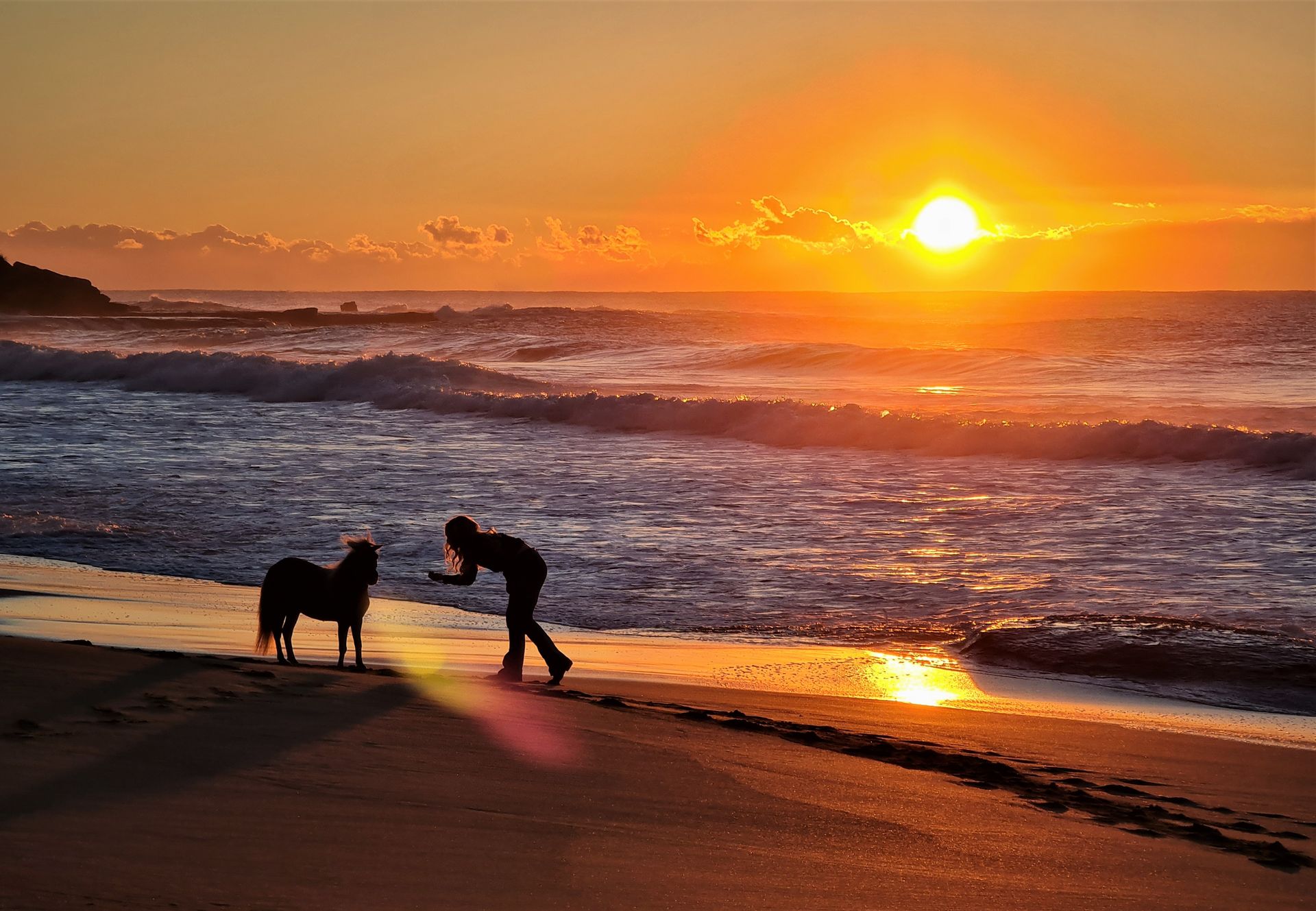
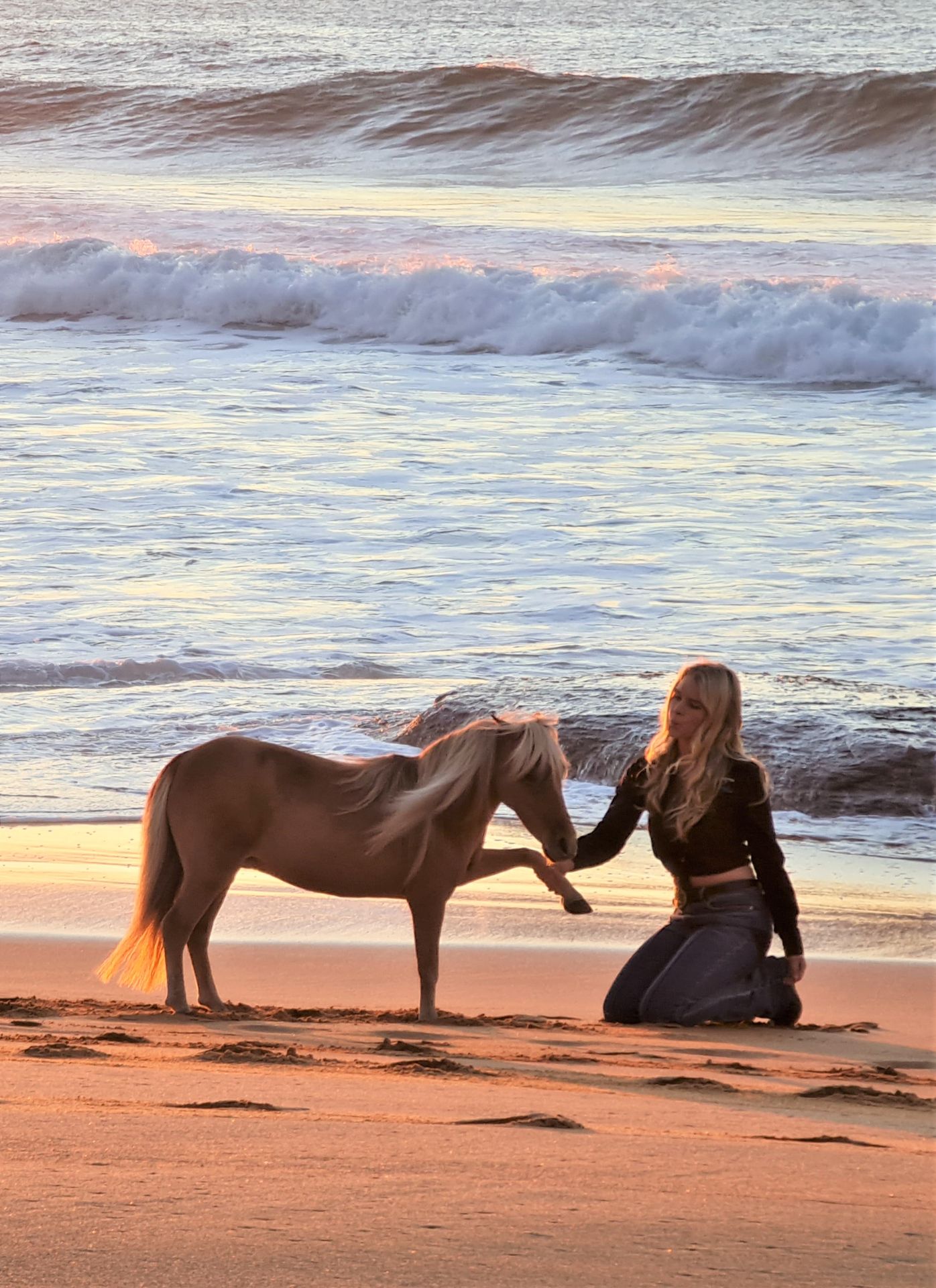
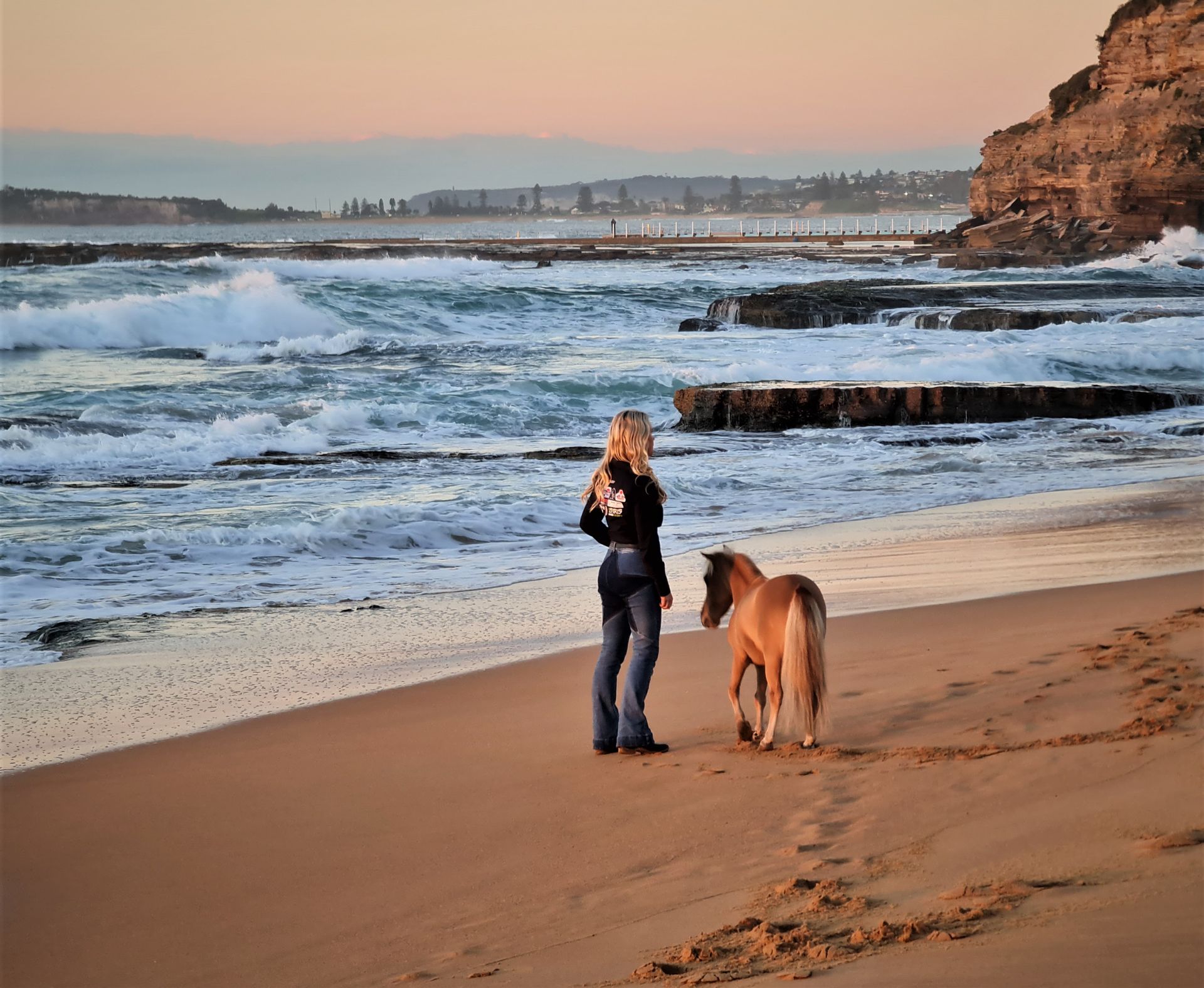
Super Blood Moon: Some Photos Of The Lunar Eclipse Lighting Up Skies From Here
Were you among those who stayed up to watch the sky on Wednesday night as a full moon passed through its closest point to Earth coincided with a lunar eclipse?
Many people had cameras ready to capture the rare orange-red moon dubbed "super blood moon". The eclipse meant it was bathed in a deep reddish glow.
While the event was best viewed from Australia's east coast, it was visible across the country and across the world.
This is a sequence taken by Michael Mannington from Bilgola Plateau:

These were taken by Kevin Murray in Warriewood and show the moon as the eclipse begins to happen and the colour of the moon afterwards:
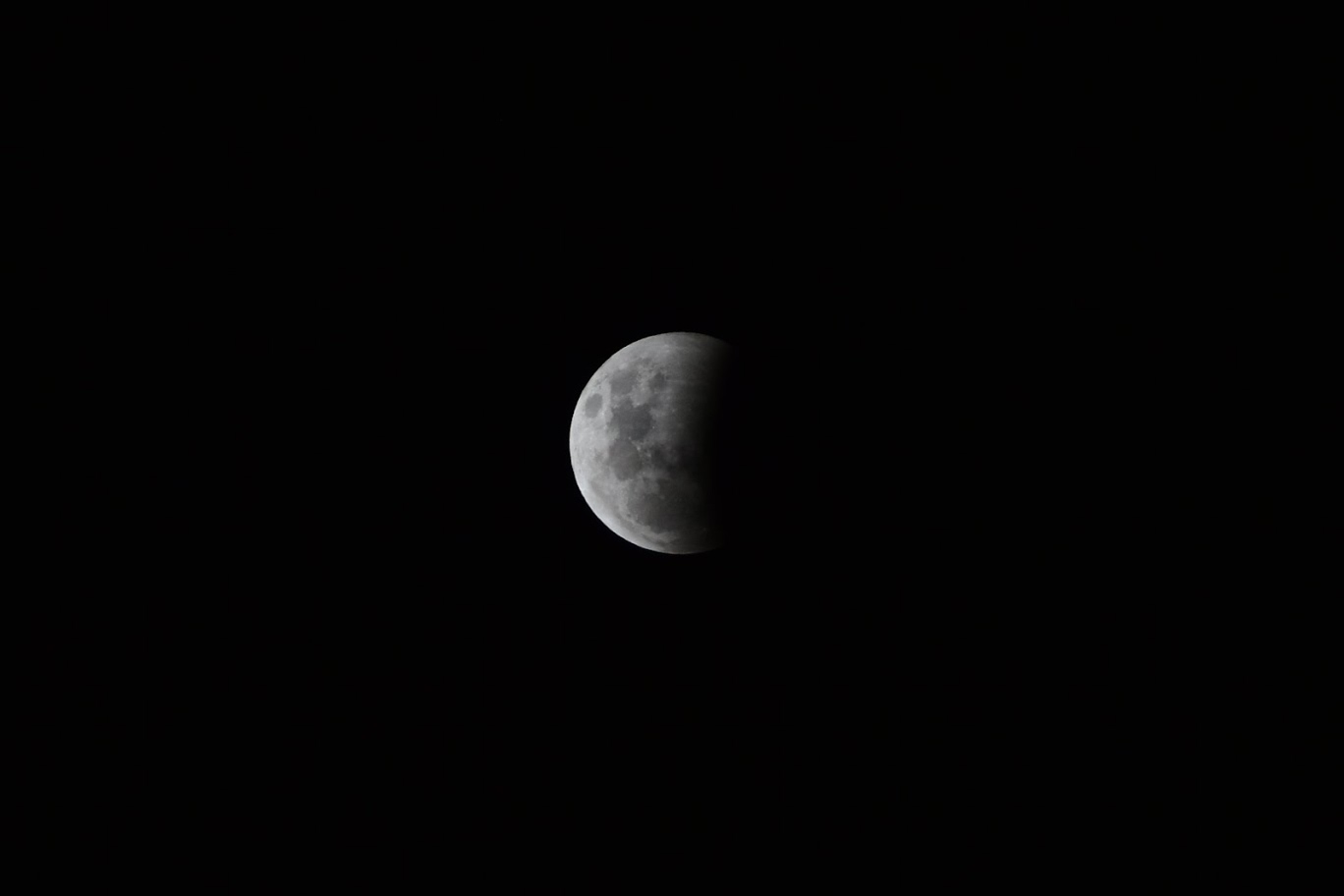
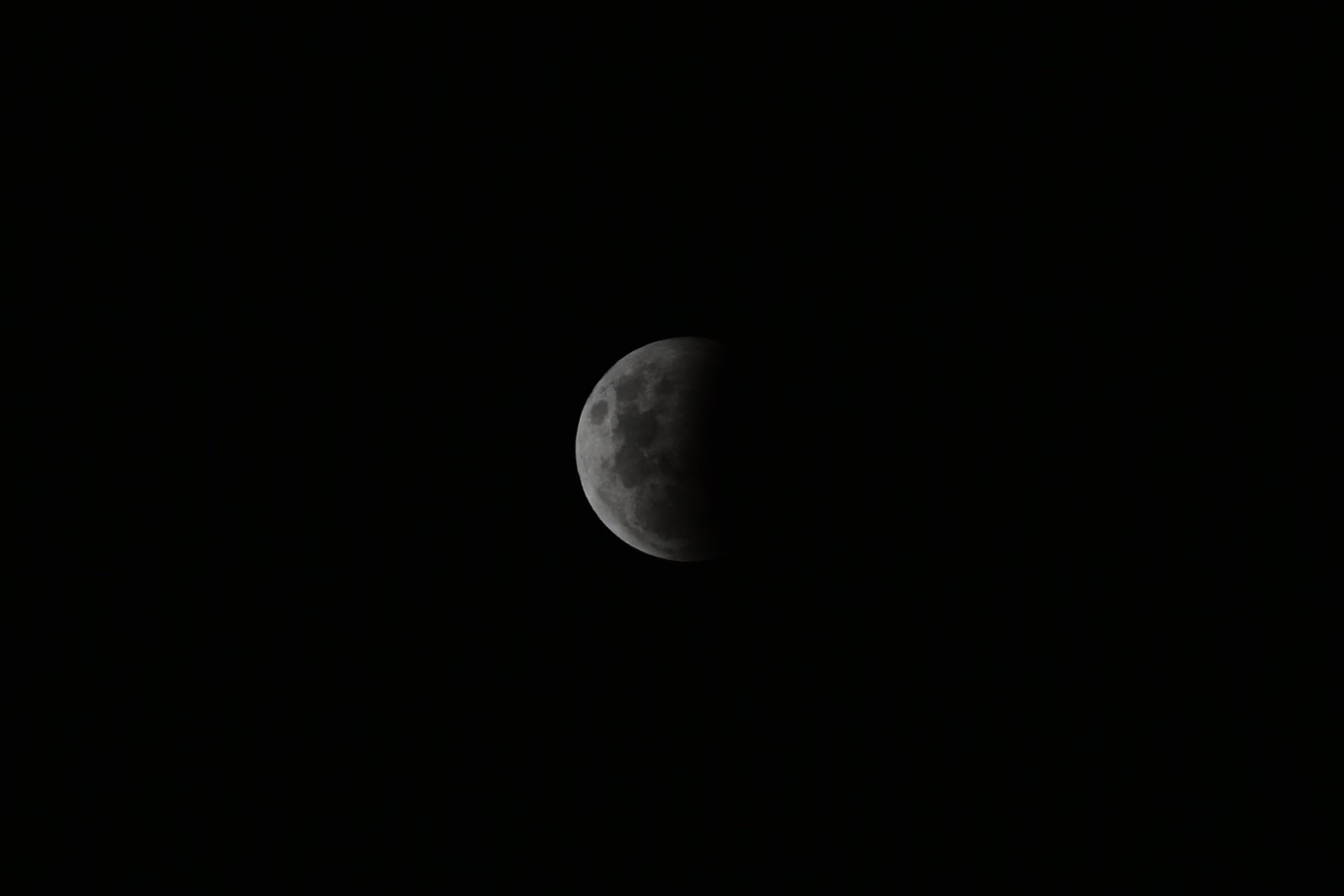
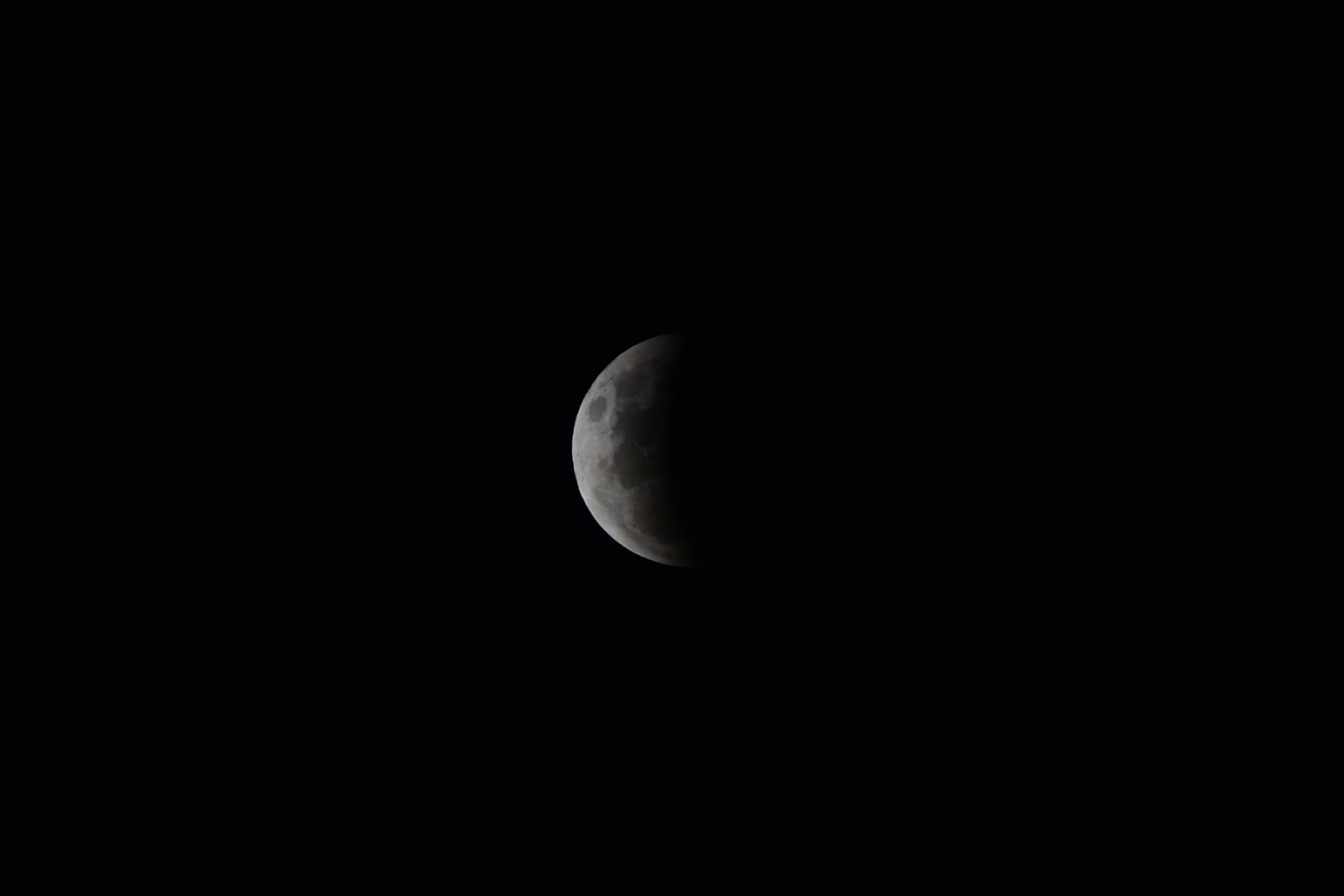
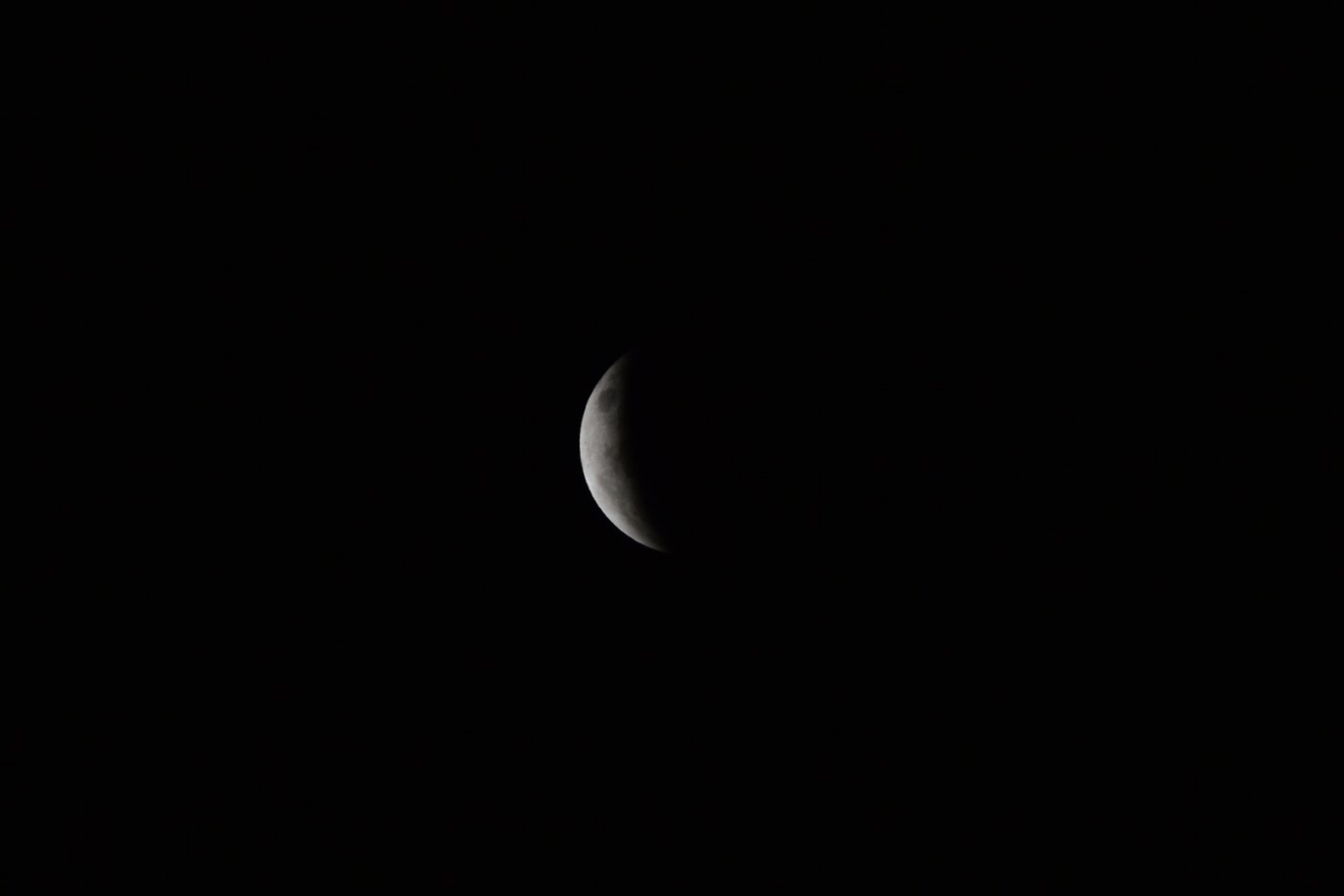



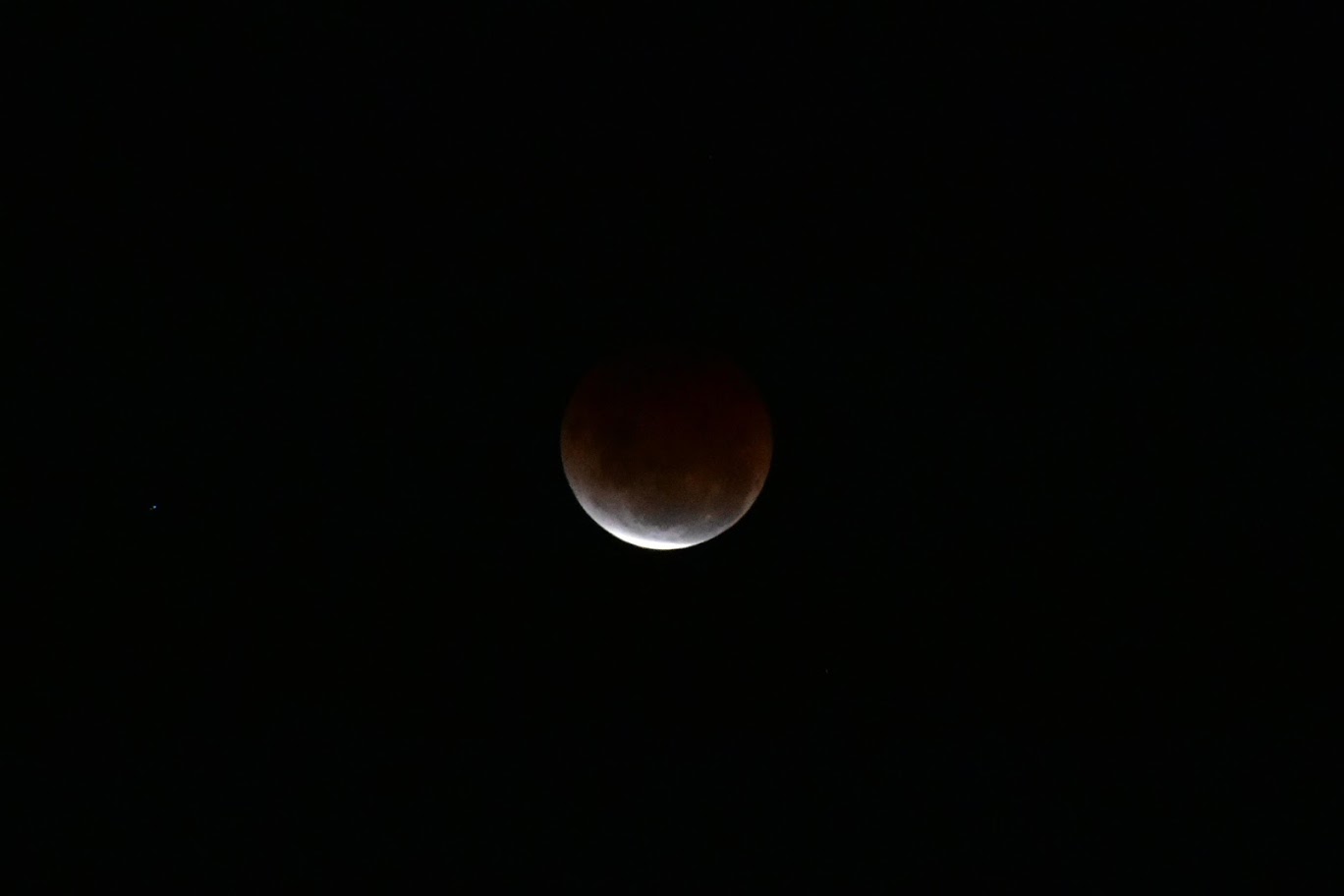
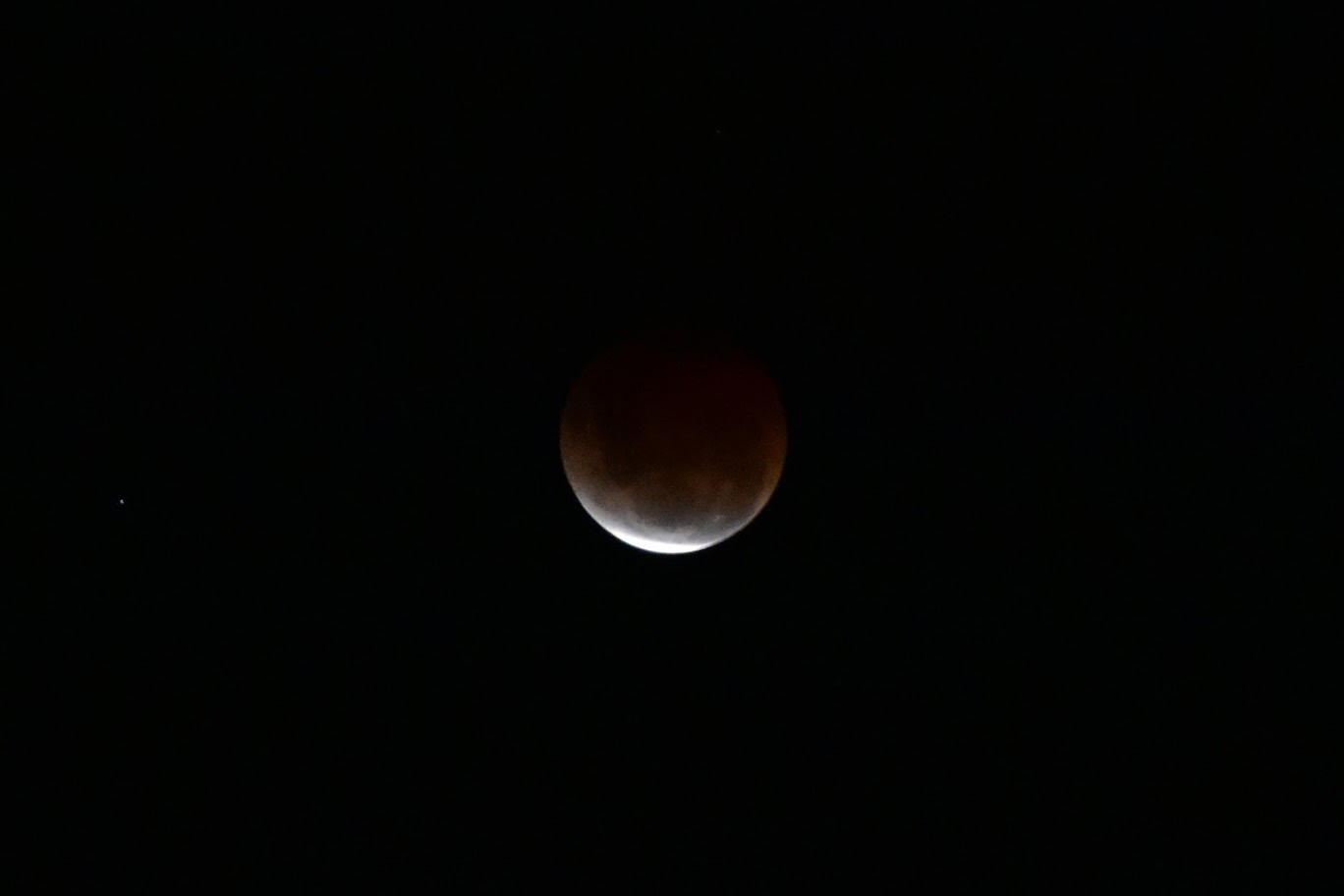
TAFE NSW Meets Skills Demand In Commercial Interior Design Boom
 TAFE NSW graduate Hanna Margetson is helping to revitalize post-COVID-19 Sydney in her new job as a Graduate Interior Designer at Axiom Workplaces.
TAFE NSW graduate Hanna Margetson is helping to revitalize post-COVID-19 Sydney in her new job as a Graduate Interior Designer at Axiom Workplaces.
Commercial Interior Design services are in demand, and office fit-outs have been on the rise in Sydney since COVID-19 as businesses adapt to new, more flexible modes of working, and inner-city landlords seek to attract businesses with modern planning solutions.
Ms Margetson’s career path with TAFE NSW has put her in great stead to meet the increased demand for commercial interior design in the wake of COVID-19. Lucky for her, she was offered a taste of the interior design sector earlier than most.
“I first encountered TAFE NSW Design Centre Enmore when I was 17 and still in high school. My school had a TVET (TAFE-Delivered Vocational Education and Training) program that allowed me to complete my final subject for the HSC at TAFE NSW,” Ms Margetson said.
“I was able to complete an industry-recognised Certificate III in Design whilst still at school, and during the process I fell in love with the culture, teachers, and design community that TAFE NSW Design Centre Enmore displayed and knew I wanted to complete further study there.”
Ms Margetson enrolled in the Diploma of Interior Design and then Bachelor of Design (Interior Design) to continue her career path. Throughout Ms Margetson’s studies, she had the opportunity to build up her industry connections and knowledge by working in part-time jobs within the design industry to gain practical experience.
“Since finishing the bachelor's degree I have been offered a position as a Graduate Interior Designer at Axiom Workplaces located in Sydney's CBD specialising in commercial workplace interior design and construction,” Ms Margetson said.
“I love my new job as a fully-fledged interior designer, and I have TAFE NSW to thank for giving me the industry connections that helped me get my foot in the door.”
TAFE NSW Head Teacher of Interior Design, Todd Packer, said COVID-19 had caused a shift in the commercial interior design sector, and increased demand to respond to changes in ways of working.
“We’ve seen that more corporate employers expect their people to work from home at least two days a week which has led to a design emphasis on custom collaboration and community spaces.
“The permanent shift to virtual teams has also forced a total rethink of the technological setup of most contemporary office spaces.”
Mr Packer said unique networking events like the Bachelor of Design (Interior Design) virtual “Industry Speed Date” helped students get the connections to secure in-demand employment after their studies.
“The Industry Speed Date provides a casual forum for local industry to interview graduating students from the Bachelor of Design (Interior Design) for potential internship placements and employment opportunities.
“We’re committed to giving our students the best possible job outcomes and these industry events are key to forging meaningful relationships between the sector and TAFE NSW,” Mr Packer said.
Ms Margetson said that the subjects she completed throughout her time at TAFE NSW provided her with a vast portfolio that explored different industries within design along with a strong understanding of the practical design process.
“TAFE NSW not only provided me with design training, but also practical workplace skills such as public speaking, presenting, time management, working within a team, punctuality and more.
“The smaller sized classes at TAFE NSW meant a personalised experience and gave me the chance to create relationships with both staff and students. The projects were always hands-on and the up-to-date training provided me with practical skills to go out into the design industry with.”
To find out more about the range of study options available at TAFE NSW including the Bachelor of Design (Interior Design), visit www.tafensw.edu.au or call 131 601.
Vaping and e-cigarettes are glamourised on social media, putting young people in harm's way
Jonine Jancey, Curtin UniversityDespite their widespread reputation as a “safer” alternative to cigarettes, e-cigarettes (also known as electronic cigarettes or vapes) are far from harmless, particularly for adolescents, whose developing brains may suffer lifelong adverse effects from nicotine-containing products.
Yet vaping and e-cigarettes are widely promoted on social media by the industry and influencers, using advertising tactics that were outlawed for tobacco in Australia in the 1980s for traditional media. This blatant promotion is not tolerated offline, so why is it happening on social media?
On Twitter, YouTube and Instagram, e-cigarettes are frequently depicted as a safe and healthy alternative to cigarettes. This is at odds with the opinion of health authorities such as the Office of the Surgeon General, the Federal Health Department and the World Health Organization (WHO). There is substantial evidence e-cigarettes have adverse health effects but because they are relatively new (they were first introduced to the US market in 2007) their long-term effects are less clear.
Yet e-cigarettes are touted online as a harmless recreational activity. Vape juice (which may or may not contain nicotine) is available in flavours such as gummy bear, chocolate treat and cherry crush, while social media influencers demonstrate fun vaping tricks or ways to customise e-cigarette devices. There are even online vaping communities offering social support and connectedness.
There is no Australian federal legislation that directly applies to e-cigarettes. Instead, several laws relating to poisons, therapeutic goods and tobacco apply. Across Australian states and territories, it is illegal to sell nicotine-containing e-cigarettes but users can legally import them through a “personal importation scheme” if they have a doctor’s prescription.
Those that do not contain nicotine can be sold in some parts of Australia, provided there are no therapeutic claims. Our research found that despite Australia’s restrictions, the internet is facilitating peoples’ access to nicotine and vaping products. An estimated three-quarters of e-cigarette purchases are done online.
Where On The Web Is Vaping Promoted?
To find this content, all you need is a smart phone and a few relevant hashtags such as product names, or related terms such as: #vape, #vapelife, #vapesale and #ejuice.
Images from Instagram, Twitter and TikTok display a mixture of modern advertising techniques and advertising tropes used for decades by the tobacco industry. There are images of scantily dressed women with e-cigarettes, details of tempting vape juice flavours, and discount offers. The scope of this content is alarming.
This promotion, coupled with the product diversity and allure, ease of online purchase and lack of appropriate age verification, supports the growth of e-cigarettes, particularly among young people. Young people are the biggest users of social media, and they are being directly targeted.
E-cigarette use has been described as an “epidemic among youth”. In Australia, since 2013, the lifetime use of e-cigarettes has significantly increased — doubling in 14-17 year olds (4.3% to 9.6%) and almost tripling in those aged 18-24 (7.9% to 26.1%), while rates of cigarette smoking have declined.
This increased e-cigarette uptake by young Australians is particularly worrying. While promotion and advertising of this product are tightly regulated offline, with age restrictions that are relatively easy to enforce, posing as an adult online is often simply a matter of ticking a box.
Despite the dangers of e-cigarettes, many adolescents have positive opinions about them. Surveys have revealed young people consider e-cigarettes to be a healthier and less addictive alternative to cigarettes, with fewer harmful chemicals and fewer health risks from second-hand vapour.
Tobacco companies have a tradition of infiltrating youth-friendly media. Almost all Australians aged between 18 and 29 use social media, for more than 100 minutes a day on average. The high visibility of e-cigarettes available on social media can foster awareness, encourage experimentation and uptake, and change social norms around vaping.
Social media platforms do have their own policies on tobacco advertising. Facebook and its subsidiary Instagram stipulate:
Advertisements must not promote electronic cigarettes, vaporizers, or any other products that simulate smoking.
This policy has now been extended to all private sales, trades, transfers or gifting of tobacco products. Any brand that posts content related to the sale or transfer of these products must restrict it to adults 18 years or older. Whether this is even possible on social media is still open to question.

Twitter’s policy on paid advertising “prohibits the promotion of tobacco products, accessories and brands globally”. But this does not extend to the content of individual accounts.
TikTok’s advertising policy states:
Ad creatives and landing page must not display or promote tobacco, tobacco-related products such as cigars, tobacco pipes, rolling papers, or e-cigarettes.

But on social media, where “influencer” content is king, the boundaries between truly organic content and paid product placements is blurred.
In 2012, Australia tried to counter this emerging online situation by introducing legislation making it an offence to advertise or promote tobacco products on the internet, unless compliant with existing advertising laws. But that legislation doesn’t ban online sales of tobacco products, including vaping products, and can do very little about advertisements from overseas websites.
It is unclear whether health authorities and regulators are aware of the scale and explicitness of e-cigarette content on social media. It seems clear that more should be done to counter it.
Australia, along with close to 170 other countries, is a signatory to the WHO’s Framework Convention on Tobacco Control , which calls on nations to outlaw all advertising for tobacco products, including e-cigarettes.
Action is required. Australia, and other nations from which this content originates, need to prioritise public health. There needs to be improved surveillance, monitoring and the curtailing of content that glamourises e-cigarettes, as well as improved age verification practices.![]()
Jonine Jancey, Academic and Director Collaboration for Evidence, Research and Impact in Public Health, Curtin University
This article is republished from The Conversation under a Creative Commons license. Read the original article.
How early Australian settlers drew maps to erase Indigenous people and push ideas of colonial superiority

The new Netflix series Shadow and Bone opens with cartographer Alina Starkov crammed into the back of a rumbling wagon, sketching a war-torn landscape. A flashback to her childhood in an orphanage shows her looking at a map of a conflict zone.
A guardian tells her, “keep a pencil in your hand, or else someone will put a rifle in it instead”. The cartographers of this fictional world are crucial to the military, just as they are in the real world. But there is also a sense that cartographers played a peaceful role in the army.
In reality, the role of surveyors and cartographers throughout history was often far from peaceful. It was their initial explorations that paved the way for destructive waves of colonising armies and civilians.
At each stage of mapping an area, clues are preserved about the priorities and prejudices of the person wielding the pencil, and those instructing them. Today, researchers can spot these clues and draw out the contextual history of the time.
Exploring The Land
Maps made it easier for the government back home to imagine the territory of a new colony, to claim to “know” and thus own it. Therefore, surveying expeditions into unknown lands were prioritised.
Some expeditions were huge, such as Lewis and Clark’s crossing of the United States. Others were small, such as James Meehan’s treks around the Derwent River in Van Diemen’s Land (Tasmania) between October 1803 and March 1804.

Meehan kept a daily log of measurements and happenings as he explored. Like many, he occasionally included sketches, probably trying to ward off boredom during the long evenings at camp.
We know through journal records that Meehan met some palawa (Tasmanian Aboriginal) people along the different routes, once firing on a group when he felt threatened.
Focused On Sought-After Utilities
Meehan’s observations were then produced for their first external audience - the colonial government. It’s here we start to see the colony’s priorities.
Many of the map labels highlight the quality of the land in terms of potential for expansion and European-style agriculture. Meehan’s map of the Hobart area emphasises whether the land encountered was hilly or flat, covered with vegetation, or cleared pasture.
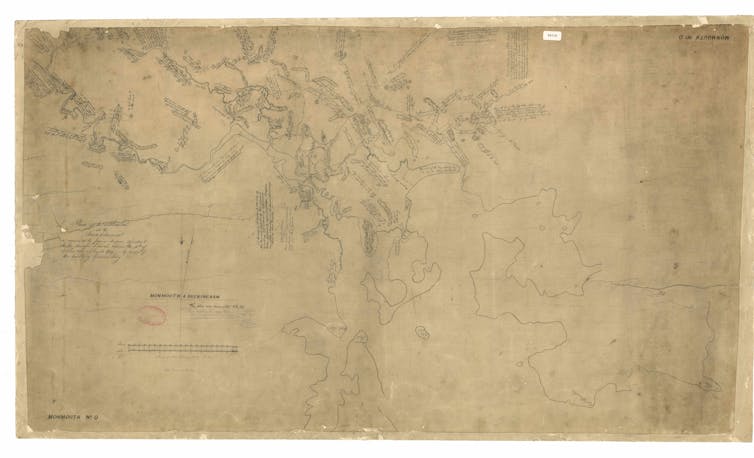
By the time Meehan drafted his “Plan of the Settlement at the River Derwent”, pictured above, the Europeans had moved from their initial camp at Risdon Cove to today’s site of Hobart. The Risdon settlement was considered a failure as the fresh water ran out and soldiers threatened mutiny, so Meehan omitted any reference to it beyond a small name label.
More importantly, he excluded any reference to any Indigenous people, despite having encountered them on more than one occasion.
Meehan was playing his part in cultivating the narrative of Van Diemen’s Land as a successful colony on an “empty” island that had been (supposedly) waiting for the Europeans to arrive. This was the same as the terra nullius narrative perpetuated by the British government regarding the mainland.
Propaganda In Map Form
Sometimes the map would be destined for wider circulation and would be refined with simple decorative features such as a key, north arrow, coloured inks and detailed illustrations of ships or gardens.
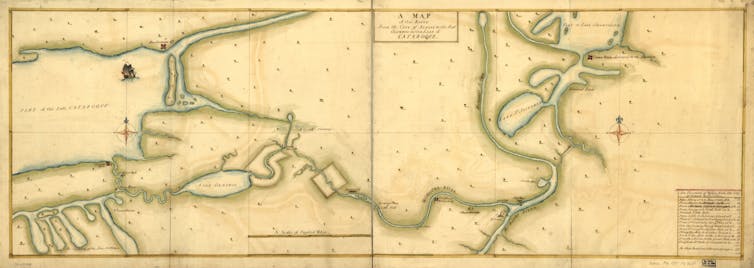
Within these more attractive maps, hidden clues became even more nuanced.
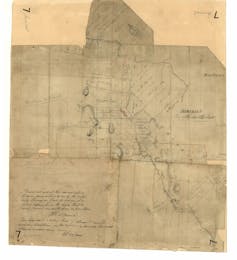
Aspirational elements were introduced, giving the viewer a sense of what the cartographer, landholder or government perceived as a desirable landscape. Phrases such as “unexplored country” would be used, or an area of blank space sparked the imagination with some promise of undiscovered wealth.
Both sketch maps and their more refined siblings were used by the ruling powers as working maps to track their increasing expansion over the land. By reading the scribbled annotations carefully, stories of changing land ownership, population growth and acts of violence become apparent.
Republishing And Distribution
Throughout the 18th and 19th centuries, geographers, engravers and others combined data from maps and reports to print single sheets and atlases they could sell at a range of prices.
These maps transported the reading public to remote locations and made them sound educated at the dinner table. Accuracy was not required for this, so mistakes were copied from one chart to another, and outdated information often circulated for decades.
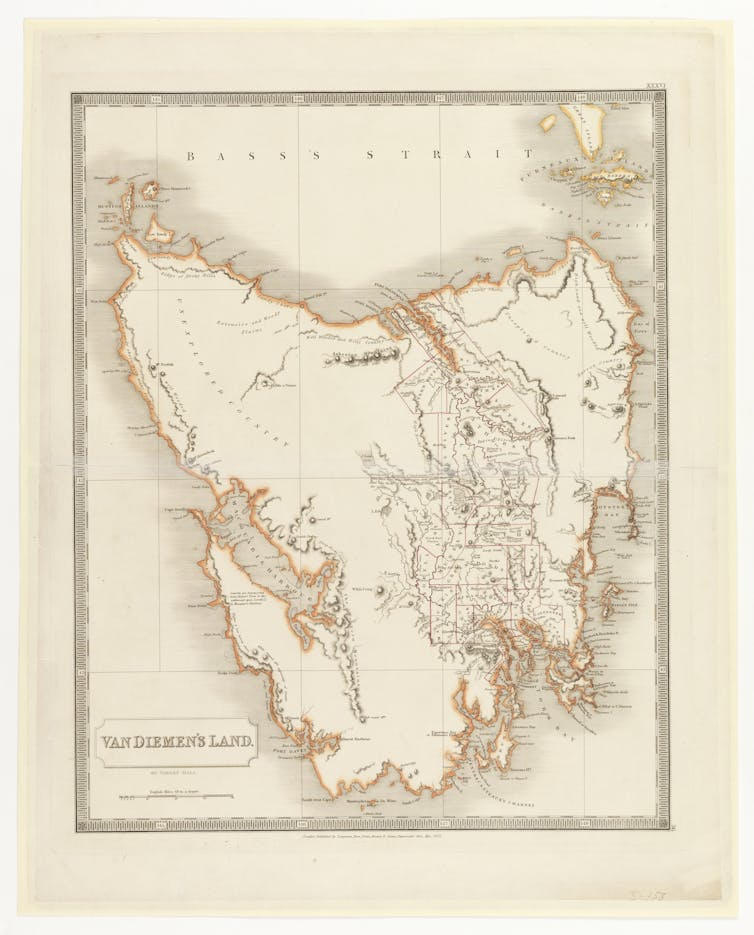
Throughout the 17th and 18th centuries, explorers’ maps and reports sometimes included references to First Nations peoples or their significant sites. Abel Tasman observed the presence of palawa people in southern Tasmania. A century later, explorers in America named “native guides” in recognition of their invaluable assistance during cross-country expeditions.
But by the end of the 18th century, changing attitudes towards First Nations peoples started to see references to them disappear from maps of European colonies around the globe.
In 1804, Meehan omitted all mention of Tasmania’s palawa people from his Derwent River map. This is a reflection of emerging ideas of colonial superiority. The Europeans were increasingly reluctant to admit to needing help from Indigenous people, or even to admit there were other people already living on the lands.
So the next time you find yourself in front of a historic map, make sure you ask what details have been included, which have been excluded and — most importantly — why?
Read more: We mapped the 'super-highways' the First Australians used to cross the ancient land ![]()
Imogen Wegman, Lecturer in Humanities, University of Tasmania
This article is republished from The Conversation under a Creative Commons license. Read the original article.
Kathrin Longhurst Awarded 2021 Archibald Packing Room Prize For Portrait Of Kate Ceberano
May 27th, 2021: Art Gallery of NSW

Packing Room Prize 2021 winner Kathrin Longhurst Kate © the artist
The Art Gallery of New South Wales’ head packer Brett Cuthbertson and his packing room team have awarded the 30th annual Archibald Packing Room Prize to Kathrin Longhurst for her portrait of the celebrated Australian singer and songwriter Kate Ceberano.
Longhurst’s painting is one of 52 finalist works from 938 entries received for the Archibald Prize 2021, which is celebrating its 100th year.
The German-born, Sydney-based artist is mostly self-taught and was previously a finalist in the Archibald Prize 2018 and Sulman Prize 2012.
The Packing Room Prize is a cash prize awarded to the best entry in the Archibald Prize as judged by the Art Gallery staff who receive, unpack and hang the entries. This year, the prize money has doubled, increasing from $1,500 to $3,000 for the winning artist.
After 40 years working at the Art Gallery, head packer Brett Cuthbertson holds 52 percent of the vote for the Packing Room Prize.
‘Kathrin’s work fits my criteria. It’s a portrait of a well-known celebrity and it looks like her! I met Kate Ceberano many years ago and Kathrin has really captured her likeness. As soon as I saw the work, I thought “that’s it”,’ said Cuthbertson.
‘This is also the first time in my tenure as head packer that I have awarded the Packing Room Prize to both a female artist and female sitter. I have been on the lookout, but this is the first time it stood out to me as a clear winner.’
Longhurst’s work is the second portrait of Kate Ceberano to win the Packing Room Prize in its 30-year history, following Peter Robertson’s win in 1994. Ceberano was also the subject of an Archibald Prize 2010 finalist portrait by Christine O'Hagan.
After learning she had won the 2021 Packing Room Prize, Longhurst said she was ecstatic.
‘I first spoke to Kate in early 2020 about collaborating on a portrait,’ says Kathrin Longhurst, a Sydney-based artist. ‘She had seen my work at the home of mutual friends, and asked if I was interested in painting her next album cover. We attempted to get together several times, but lockdowns and border closures lead to every trip being cancelled.
‘In 2020, the pandemic decimated the entertainment industry. The extended lockdown in Melbourne had devastating consequences for Kate and many of her fellow performers. But it ended up being an enormous year of growth and personal breakthroughs for her, culminating in her decision to move her family to Sydney to chase the work.
‘This is when we finally met. Although the album cover deadline had expired, we decided to paint the portrait to create a record of Kate at this important moment in her life, and as a legacy for her daughter.’
‘I was quite daunted before painting this portrait, as Kate is such an iconic person and there are so many incredible images of her already out there. I really wanted to create something new and fresh that captures her personal growth after the devastating consequences of lockdown on the entertainment industry last year. I painted her larger than life, looking fiercer and stronger than ever before.’
An Australian entertainment icon, Ceberano has released 28 albums over 40 years, hitting the Top 10 charts across five decades, and won three ARIA awards. She was the first woman inducted into the Australian Songwriters Association Hall of Fame in 2014.
This year, 2144 entries were received for the Archibald, Wynne and Sulman Prizes, making it the second highest number of entries following the 2020 record year. The Art Gallery also received the highest ever total number of entries by Aboriginal artists across the three prizes.
The Archibald Prize received 938 entries for its centenary year; the Sulman Prize received 546 entries; and the Wynne Prize received 660 entries. For the first time, there are more finalist works by women than men across the three prizes.
The Archibald, Wynne and Sulman Prizes, the Young Archie competition and the Archibald Prize regional tour are all generously supported by presenting partner, ANZ.
Mark Whelan, Group Executive, Institutional at ANZ said: ‘ANZ has a proud history of supporting the arts community in Australia. We are delighted to announce that the prize money has doubled in recognition of the 30th anniversary of the Packing Room Prize. This is an important award and we congratulate artist Kathrin Longhurst on receiving the 2021 Packing Room Prize.’
The Archibald Prize, first awarded in 1921, is the country’s favourite art award, and one of its most prestigious. Awarded to the best portrait painting, it’s a who’s who of Australian culture – from politicians to celebrities, sporting heroes to artists.
Finalists for the Archibald, Wynne and Sulman Prizes 2021 were also announced today, as were the finalists for the 2021 Young Archie competition, for which there were more than 2100 entries (40 selected as finalists + 20 honourable mentions).
Finalists in all Prizes will be exhibited at the Art Gallery of NSW from the 5th of June to 26th of September 2021 alongside Archie 100: A Century of the Archibald Prize, a landmark exhibition exploring the rich history of the Archibald Prize. Visitors can book a date and time to see the Archibald, Wynne and Sulman Prizes 2021 and use the same ticket to see Archie 100 any day and time it's open.
The Archibald Prize 2021 exhibition will travel to six venues in regional New South Wales and Victoria from October 2021, offering audiences around the country the opportunity to see all finalist works.
A great Kate song for all those who choose to pursue the Arts:
From Grace Tame to Craig Foster: distinguished public figures but only one politician in a telling 2021 Archibald shortlist

In its centenary year, the 2021 Archibald Prize exhibition has been relocated to the Art Gallery of New South Wales’s spacious, second floor. Visitors thus enter the Archibald via the finalists for the Sulman Prize: sometimes regarded as a poor relation to the glamorous and newsworthy portrait prize.
Still, not a few artists have either begun or enhanced their public profile by entering the Sulman, which is judged by one individual rather than the gallery trustees who vote on the Archibald. This year’s Sulman entries are the usual mixed bunch, but Marisa Purcell’s That Time of Day is a witty riff on Yves Klein’s classic blue. Paul Selwood, meanwhile, has pulled off a coup with his finely beaten metal Construction Zone, which is in two dimensions while maintaining the illusion of being 3D.

Some years there is an obvious candidate (or two) for the Archibald Prize. This is not one of those years. It is quite a strong field with many entries either by previous winners, or of them. The subjects range from self-portraits to fellow artists, actors and writers.
There are many portraits of public figures, including Grace Tame, Craig Foster and the biosecurity expert Professor Chandini Raina Macintyre — but only one politician (Victoria Atkinson’s painting of Liberal politician Trent Zimmerman).
If the Archibald reflects who Australians value as subjects to be honoured in some kind of immortality, this is another indication of the reduced standing of our political class.

This being the centenary year, the trustees can be forgiven for showing some sentiment. Peter Wegner’s portrait of artist Guy Warren is not the strongest work in the exhibition, but his subject has the distinction of being both a former Archibald winner and the same age as the prize.

It is, however, livelier than Mira Whale’s portrait of another winning artist, Ben Quilty, who is shown sleeping on a lounge.
In past years, artists have complained the trustees were biased towards large works when selecting their shortlist. There can be no such complaint this year. A delightful wall of almost miniature portraits includes (previous winner) Natasha Bieniek’s study of actor/director Rachel Griffiths and Xeni Kusumitra’s adrift — a portrait of Campbelltown Arts Centre’s Director, Michael Dagostino.

Some previous prize winners have put in very strong entries. Fiona Lowry’s Matthys, of the artist Matthys Gerber under the shower is both light-hearted and insightful.
Joan Ross, a previous Sulman Prize winner, has an unusual but muted self-portrait: Joan as a colonial woman looking at the future.

Marikit Santiago, who won the Sulman Prize last year, has entered what must be this year’s most intriguing entry. Filipiniana (self-portrait in collaboration with Maella Santiago Pearl) is a double portrait with two overlapping figures, both in traditional dress.
It is unusual not only in its tribute to older traditions of Philippine art but because the artist has chosen to paint on a large, flattened cardboard box. This has led to the painted surface appearing especially flat, emphasising the decorative nature of the composition.
Perhaps I am biased, but I do find artists’ portraits of fellow artists especially interesting. Jonathan Dalton has taken an unusual approach in his dual study of one of our most gloriously anarchic artists, Ramesh Nithiyendran.

Painted in an academic style far removed from the approach of his subject, the artist is shown as being identical twins, one with a camera scrutinising the viewer.
By way of contrast, Benjamin Aitken’s painting of the distinguished artist Gareth Sansom uses the texture of paint to evoke a sense of the artist’s interior life.

The same intelligent use of paint is seen in one of my personal favourites, Euan Macleod’s portrait of Blak Douglas. Macleod is a former Archibald winner, but to my mind this is a stronger work than the self-portrait awarded the prize in 1999.
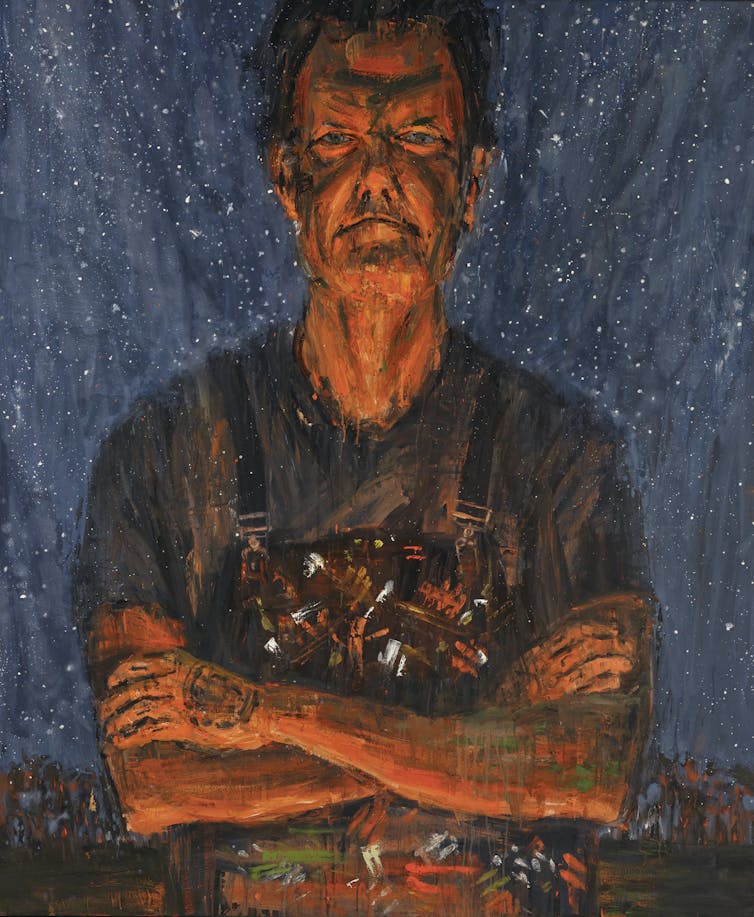
Blak Douglas (aka Adam Hill) is a frequent Archibald finalist, sadly not hung this year. Macleod gives a sense of his height, his imposing presence, and the intensity of his persona.
This year’s Packing Room Prize has gone to Kathrin Longhurst’s portrait of singer Kate Ceberano. This is the second time a portrait of Ceberano has won this prize, so clearly the subject is a favourite of the packers.
What is intriguing about this year’s Archibald is that many of the public figures celebrated by the art are, like Tame, O'Brien and Foster, openly critical of the behaviour of some of the political class. Perhaps the artists are speaking for many of us.
This year’s Archibald winner will be announced in a week’s time, on June 4.
Correction: this article originally stated there were no portraits of politicians among the 2021 Archibald finalists.![]()
Joanna Mendelssohn, Principal Fellow (Hon), Victorian College of the Arts, University of Melbourne. Editor in Chief, Design and Art of Australia Online, The University of Melbourne
This article is republished from The Conversation under a Creative Commons license. Read the original article.
Vale Eric Carle: creator of The Very Hungry Caterpillar, a story of hope ... and holes
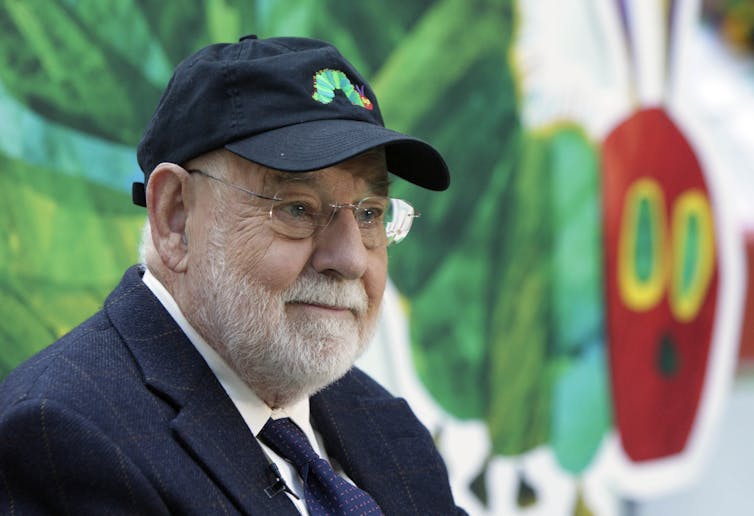
Eric Carle, author and illustrator of beloved children’s book, The Very Hungry Caterpillar, died on Sunday — the same day his famous caterpillar is born.
One Sunday morning, the warm sun came up — and pop! — out of the egg came a very tiny and hungry caterpillar.
Described by author Mo Willems as a “gentleman with a mischievous charm”, Carle might have appreciated the irony.
All living things grow and change and die.
But while a caterpillar’s life is spectacularly short, Carle lived for 91 years. He wrote more than 70 books. His most celebrated, The Very Hungry Caterpillar, is frequently cited as one of the best picture books of all time. With just 224 words, it has sold roughly a copy per minute since its publication in 1969.
Growing Wings
Despite The Very Hungry Caterpillar’s success, Carle always seemed baffled by the persistent buzz.
In 2014, when asked about the book’s popularity, Carle responded, “I haven’t come up with an answer, but I think it’s a book of hope”.
A decade earlier, he seemed more settled on the idea:
I remember that as a child, I always felt I would never grow up and be big and articulate and intelligent. ‘Caterpillar’ is a book of hope: you, too, can grow up and grow wings.
Remarkably, Carle remained humble. In an interview he gave not long before his death, Carle quietly acknowledged the importance of his work.
“You know, now it’s sinking in,” he said. “It’s taken me a long time to realise, and it is sinking in.”
A Glimmer Of Hope
Like many children’s authors, Carle enlists fantasy to serve the narrative. He speaks to children through animals and insects. In books like Brown Bear, Brown Bear, What Do You See? (written by Bill Martin) he gives agency to bugs and beetles, and situates the smallest creatures on the same continuum as humans. His work comforts us. The predictable and noncontroversial behaviour of animals is reassuring.
Unlike humans, animals are consistent.
Carle’s caterpillar might be gluttonous, but at least he is true to himself. And he doesn’t apologise for his appetite. He is very hungry, after all.
Read more: Empathy starts early: 5 Australian picture books that celebrate diversity
The book hasn’t been without controversy.
Both George W. Bush and Hilary Clinton read the book to children on their campaign trails — with Bush earning digs for refusing to read any other books, and naming Caterpillar as his favourite children’s book, even though it came out when he was 23.
The American Academy of Pediatrics uses the book as a learning tool to promote healthy eating and educate about the risks of obesity.
Read more: Abused, neglected, abandoned — did Roald Dahl hate children as much as the witches did?
A Book Full Of Holes
A child of wartime trauma, with a background in graphic design and advertising, Carle was playing around with a hole punch when he had the idea for a story about a bookworm. The Very Hungry Caterpillar was originally titled A Week with Willi the Worm. But Carle’s first choice of critter was abandoned at the suggestion of his editor, Ann Beneduce, who insisted worms didn’t make likeable characters.
Thus, The Very Hungry Caterpillar emerged, followed by The Very Busy Spider, The Very Quiet Cricket, and The Very Lonely Firefly.
Carle went on to write about grouchy ladybugs, dejected chameleons, even homeless hermit crabs — but never a worm.

Art Of Wonder
Despite his prolific publishing career, Carle didn’t think of himself as an author, preferring instead the term “picture writer”.
His style is distinct: minimalist text, vibrant illustrations and a multisensory reading experience that moves beyond the simple turning of a page.
The Very Lonely Firefly, for example, includes a set of battery-operated twinkling lights. Mister Seahorse, the story of a fish father who cares for his babies, contains transparent inserts printed with sea environments that can be overlayed as semi-opaque pages.
In Caterpillar, the page width is progressively increased to reflect the quantity of food consumed. Each image of food has a caterpillar-sized hole cutout, as if it has been chomped through.
Ultimately, after some mild abdominal pain and a medicinal green leaf, he transforms into a handsome butterfly.
Carle’s multifaceted practice, combined with his distinctive visual language, transforms his books into objects of wonder and play, lending themselves to repeated readings.
Moreover, while Carle’s images are carefully constructed through technical processes, his work maintains a childlike quality.
His images reflect how children see their world — a series of bold shapes, exaggerated features and fields of moving colour (an effect achieved by collaging on hand-painted tissue).
Indeed, Carle’s bold and bright colours are particularly effective given what we know about the developmental stages of a child’s vision: younger children are better able to perceive and distinguish between bright colours than fainter shades.
Carle called his work “deceptively simple”, a great accomplishment for a man, who — in his words — tried “all his life to simplify things”.
Read more: Unpacking the magic of Miffy, a simply drawn, bunny-shaped friend
Correction: this article originally included quotes from a 2015 interview published online by The Paris Review. The publication has now stated that the interview was a parody.![]()
Kate Cantrell, Lecturer in Writing, Editing, and Publishing, University of Southern Queensland and Rhiannan Johnson, Lecturer in Visual Art, University of Southern Queensland
This article is republished from The Conversation under a Creative Commons license. Read the original article.
What is 'Other' in my iPhone storage, why is it taking up so much space and how do I clear it?

If you’re an iPhone user, check your storage now by selecting Settings, then General and then iPhone Storage.
You’ll probably see a lot of recognisable categories eating up your storage — apps, photos, and so on. But there is one, often rather large category, that may raise concerns: “Other”.
It’s shaded light grey and often represents a significant proportion of the overall storage available.
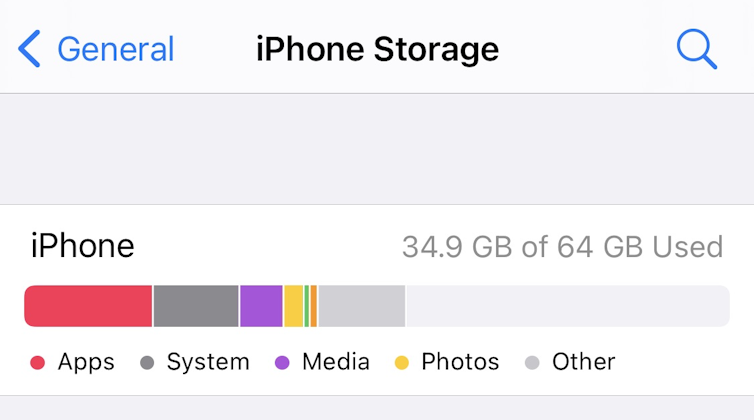
What Is ‘Other’?
For more detail, scroll down and tap the “Other” category (right at the end). It doesn’t say much — just that it includes caches, logs and other resources in use by the system. Not very illuminating.

Logs are records of actions undertaken on, or by, our phones. A phone may, for example, log that it connected to a WiFi network, established a Bluetooth connection with a device, backed up some data or opened a web page. In most cases, the log files are simple records that do not occupy much space — often only a few megabytes.
Caches, however, can be a much greater problem for clogging up your “Other” storage.
When we stream media such as movies and music on an iPhone, the phone will download as much of the content as possible. One of the main reasons for this is to minimise the dreaded spinning wheel you see when content is buffering.

All this content (referred to as a “cache”) needs to be stored somewhere and it rapidly fills up your device.
This cached content extends to a wide range of applications including your web browser (such as Safari, Chrome or Firefox) and apps like Facebook, Instagram, Twitter and TikTok.
Why Is It Taking Up So Much Space?
While cached data may not seem to need much space, it is surprising how large streamed media content can be – not to mention the image-rich social media apps we love so much.

Looking through the list of apps and their storage allocations will quickly show how storage is being consumed. In this screenshot above, for example, you can see Facebook is consuming 2.17 gigabytes.
However, if we look on the App store, it says the Facebook app only requires 255.4 megabytes. So somehow the app is occupying an additional 1.9GB. Where is this extra 1.9GB coming from? It’s likely caches of images, videos and other content your phone had to store in it’s own memory storage so you could scroll through Facebook without encountering the dreaded “buffering” spinning wheel.

How Do I Clear ‘Other’ Or Get Rid Of It?
The most effective solution is also the most radical. To truly minimise “Other” storage, you would need to backup your phone, reset it and, finally, restore your phone from the backup.
This process will remove most of the “Other” storage being used on your iPhone, but takes a bit of time and effort.
How Can I Stop It Getting So Large In The Future?
Unfortunately, cached files will be recreated with most common iPhone usage. But there are some things you can do to reduce storage consumption.
If you’re not keen to reset, try exploring the apps using up cache space on your iPhone.
Social media apps are a good starting point as they often cache lots of images and videos. While most don’t provide an option to delete their cached data, removing and reinstalling the app will remove all cache files.
Another likely culprit is your web browser (typically Safari on most iPhones).
From the Settings menu, scroll down to Safari and select “Clear History and Website Data”. This will remove most cached data associated with your web browser.
If you’re using another browser, such as Chrome or Firefox, repeat the steps with that browser in Settings.

Great. Any Other IPhone Storage Tips And Tricks?
If you want to keep going, consider removing old SMS and iMessages.
Standard written text messages occupy minimal storage, but photos and videos shared between family and friends can consume significant storage over time.
Under Settings, scroll down to Messages, then to the Message History option. The default is to keep messages “forever”. Changing this to a shorter duration can reduce space requirements considerably.

A final option is to consider offloading apps. Modern iPhones let you remove infrequently used apps. While this will not necessarily reduce your use of cache storage, it can free up valuable space.

There is no simple solution to managing iPhone storage usage. Minimising photos and videos will help, but there is a lot of space allocated to apps and their cached data.
But with careful tending, we can try to keep on top of unexpected storage usage without having to wipe our devices![]()
Paul Haskell-Dowland, Associate Dean (Computing and Security), Edith Cowan University and Patryk Szewczyk, Senior lecturer, Edith Cowan University
This article is republished from The Conversation under a Creative Commons license. Read the original article.
5-metre pedestals, an Anna Wintour puppet... COVID-19 changed fashion shows but the runway will survive

Australian Fashion Week, which starts next Monday, is touting itself as one of the first live fashion shows since the COVID-19 pandemic began. Runway shows will feature established labels as well as younger designers.
For decades, journalists, editors, buyers, celebrities and taste-makers would descend twice a year on Paris, New York, London and Milan to attend the famous fashion weeks, where global and emerging designers present new collections in runway shows. Tokyo, Shanghai, Seoul and Moscow have joined these four global fashion centres, along with Australian cities.
Fashion shows began in the early 1900s. Their primary purpose has always been about promoting and selling new product. (The fundamental rule of fashion is endless change and newness.) The pandemic has changed things, forcing them online. But the world of high fashion had already been experimenting with technology on the catwalk — from launching handbags and frocks attached to drones to presenting a digital show beamed to viewers with 3D glasses.
Read more: Friday essay: how New York Fashion Week came to be
In the early 2000s, runway shows were grand spectacles. In 2005, Chanel began using Paris’s Grand Palais as a set on which Karl Lagerfeld envisaged grandiose installations recreating microcosms of everyday life. They included a supermarket; an airline desk; a beach, complete with sand and water; and a library.
In 2008-2009, at the height of the financial global crisis, one runway became a giant merry-go-round, carrying oversized pendants, bags and pearl bracelets.
Other luxury brands such as Dior and Dolce & Gabbana organised shows in exotic locations, such as Marrakesh, Mexico City, Capri and Hong Kong, flying visitors in at great expense.
Digital Collections And Social Distancing
Then came COVID-19. It has had a huge economic impact, highlighting fashion’s environmental and ethically unsustainable practices. Brands that have survived moved to digital presentations of their collections with the pandemic forcing designers to think in fresh ways.
Valentino’s Pier Paolo Piccioli, for instance, dealt with rules of social distancing by setting 15 models on pedestals up to 5 metres high and creating elongated silhouettes of white couture dresses. Textile patterns and colours were then projected on these silhouettes.
In September 2020 in Milan, Jeremy Scott, Moschino’s designer, created a COVID-safe fashion show that eliminated both models and audience. Forty miniature marionettes, 76 centimetres tall, walked the runway between two rows of puppets replacing the audience.
In the first row, a puppet version of Vogue editor-in-chief and fashion power broker Anna Wintour stood out.
In October, Chanel returned to a live show with an audience to present the ready-to-wear Spring/Summer 2021, but a new COVID lockdown in Paris prevented any further live shows in 2020. Its 2020/21 Haute Couture collection was a digital show streamed from a chateau in the Loire region.
Drones And 3D
Still, some major global brands had already been presenting digital alongside physical shows, or toying with technology.
Read more: Why STEM subjects and fashion design go hand in hand
In February 2010, Burberry experimented with live streaming its womenswear collection digitally in 3D in five locations. Journalists and celebrities were invited to private screening spaces in Paris, New York, Dubai, Tokyo and Los Angeles where they watched the show with 3D glasses. The show took inspiration from the popularity of James Cameron’s film Avatar (2009).
In 2014, Fendi sent three drones down the runway to film a show. The move created excitement, but also raised concerns related to hyper-surveillance.
In February 2018, meanwhile, Dolce & Gabbana showed their new bag collection attached to drones. Small drones glided down the runway and over the heads of the audience before vacating the stage for models.
Given models are often also celebrities, embodying the designer’s concept for the collection, or even brand, this was a startling move. Will real models be dispensed of in a near future? Will they be replaced by drones, robots or holograms?
In the same year, in Jeddah, Saudi Arabia, fluttering clothes were sent on the runway attached to drones, producing a ghost-like effect. The show prompted outrage on social media. Organisers explained it was about adding novelty. However, it was the first time a fashion show had been opened to an audience of both men and women, instead of just women. This change may have prompted the use of drones.
Fashion is a major industry commanding 2% of the world’s Gross Domestic Product annually. Runway shows are marketing devices and here to stay.
In-person audiences will be allowed during Paris Fashion Week in July, and in June in Milan, for the menswear collections. The British Fashion Council is also preparing to hold COVID-safe, smaller, in-person events. Still, brands will continue to experiment with technologies in the name of novelty.![]()
Tiziana Ferrero-Regis, Senior Lecturer, Study Area Coordinator, Fashion, Queensland University of Technology
This article is republished from The Conversation under a Creative Commons license. Read the original article.
Full Steam Ahead For UniSA's Train Software App
Mouse Studies Find Sugar-Free Energy Drinks Just As Harmful
A Breakthrough To Make It Beta: Blocking Out Stress To Treat Cancer
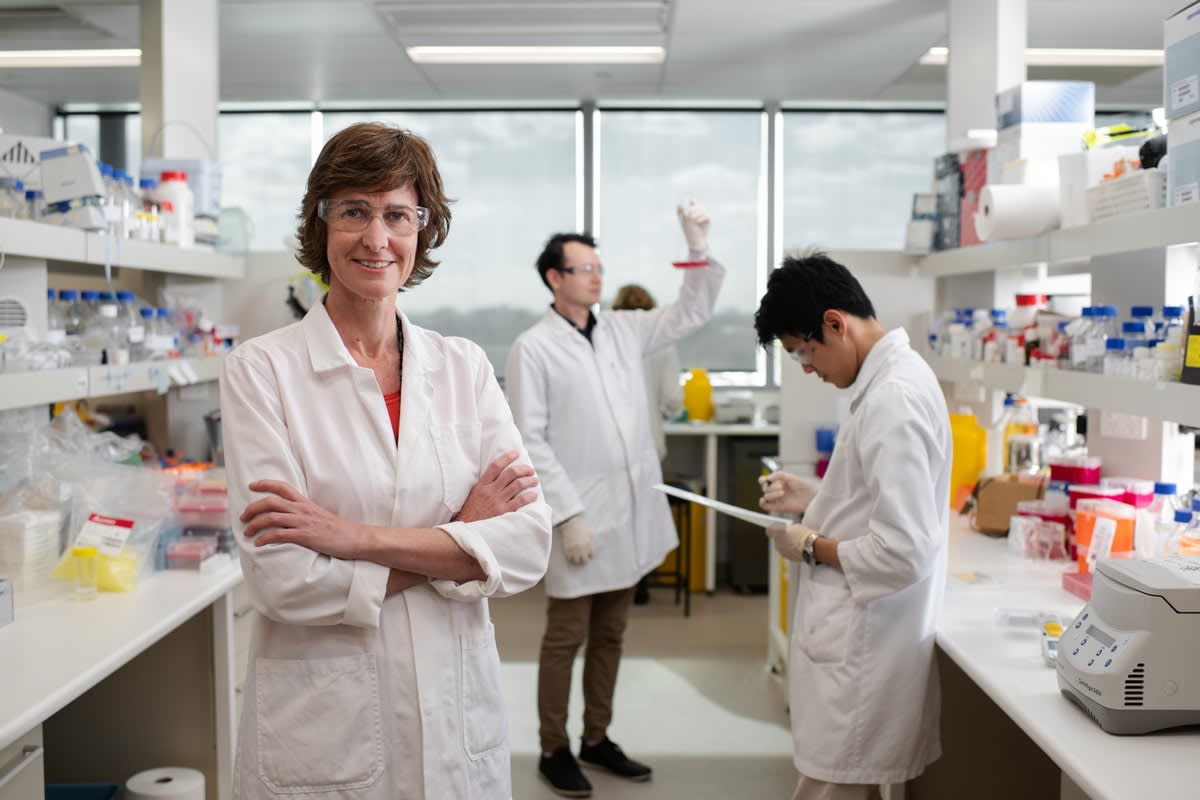
Antarctic Ice Sheet Retreat Could Trigger Chain Reaction
Astronomers Find Milky Way Not Unusual

Delivering Serendipity: Seemingly Random Product Discovery Aided By Technology
New Study Targets Secrets Of Great Entrepreneurial Cities
Synchrotron X-Ray Experiment Reveals A Small Nudge With Big Consequences
Disclaimer: These articles are not intended to provide medical advice, diagnosis or treatment. Views expressed here do not necessarily reflect those of Pittwater Online News or its staff.